Pablo Neruda Foundation
Darío Oses

Journalist and Master in Latin American Studies (University of Chile). Director of the Pablo Neruda Foundation Library.

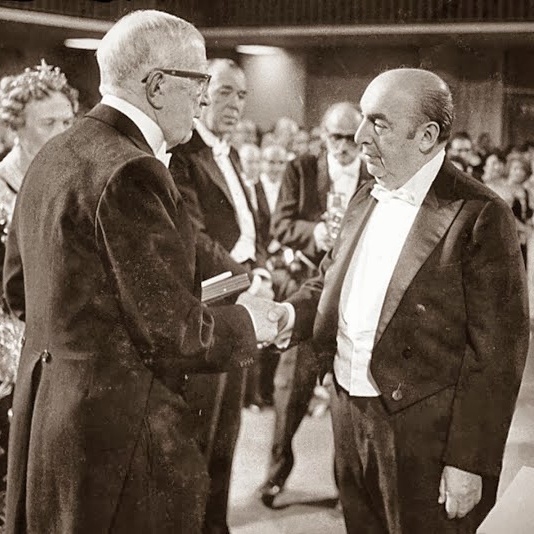
The Society of Chilean Bibliophiles, together with the Società Bibliografica Toscana, from Italy, are pleased to invite you to visit this virtual exhibition.
We thank, the Pablo Neruda Foundation in Chile, the Cultural Heritage Corporation, and the General Historical Archive of the Ministry of Foreign Affairs. In Italy we thank to Alberto Tallone Editore and the Ignazio Cerio Capri Center Library.
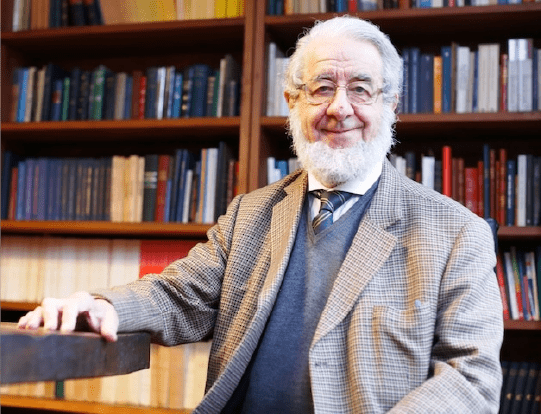
The historian Ricardo Couyoumdjian, President of the Society of Chilean Bibliophiles, greets you and welcomes you.
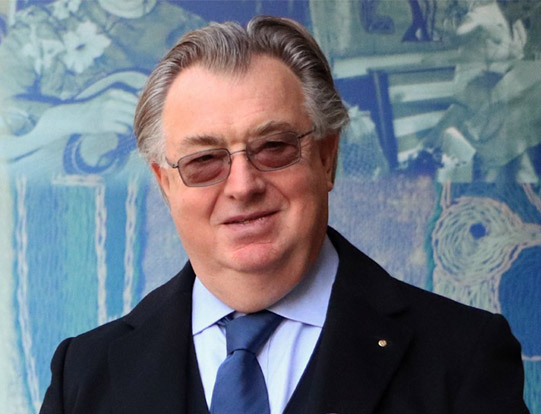
The lawyer Paolo Tiezzi Mazzoni della Stella Maestri, President of the la Società Bibliografica Toscana, greets you and welcomes you.
The Society of Chilean Bibliophiles, founded in 1945, aims to preserve the “culture of the book”. For this reason, it brings together collectors, promotes research and publishes old editions of Chilean heritage value in the fields of Literature, Law, History, Arts and Sciences.
On August 12, 2019, our Chilean-Italian international phase began, both for the Society of Chilean Bibliophiles and for the Società Bibliografica Toscana. That day, we signed an International Cultural Cooperation Protocol, with the aim of carrying out together various exhibition projects, book publications and other activities of common interest to the public.
This year 2020, to celebrate 75 years of activity, we honour our most outstanding member: Pablo Neruda, who on December 10, 1971 received the Nobel Prize for Literature. With this inspiration, we have prepared, together with the Italian friends of the Società Bibliografica Toscana, our first virtual exhibition, which consists of the following parts:
(I) Neruda Bibliophile
(II) Neruda and the collectors in Chile
(III) Neruda in Italy
In all three, we will find texts little known by the public, which will provide us with new points of view about their creative richness that, in itself, configures a poetic world where there is still much to discover.
All of us who work on this project are certain that culture is a bridge that unites countries. In this particular case, the great poetic work of Pablo Neruda - recognized and valued throughout the world - is a bridge that unites Chile and Italy, two countries that are geographically far apart, but close due to our common Latin base, by our great affinity and solid friendship.
Due to the pandemic, we are offering you a virtual exhibition that, we hope, will be a beautiful bibliophile and poetic experience for you.
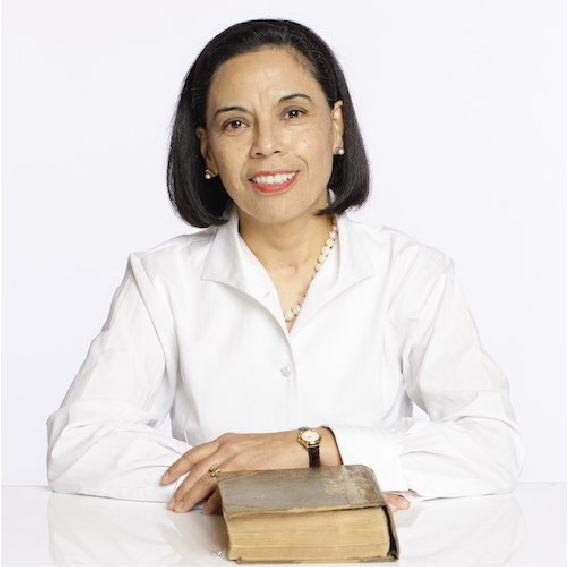
Norma Alcaman Riffo
Master in Literature and Diploma in Cultural Administration. Writer.
Director of the Society of Chilean Bibliophiles and Member of the Società Bibliografica Toscana, in Italy. Director of this virtual exhibition.
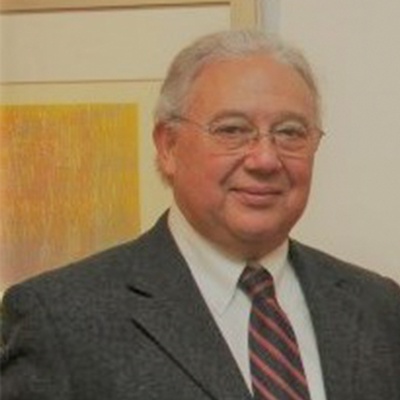
Enrique Inda, Architect. Director de la Society Of Chileans Bibliophiles y Vice President of the Foundation Pablo Neruda. Collector of Neruda`s work.

Ignacio Swett, Civil Engineer. Treasurer of the Society of Chilean Bibliophiles. Collector of Neruda`s work.

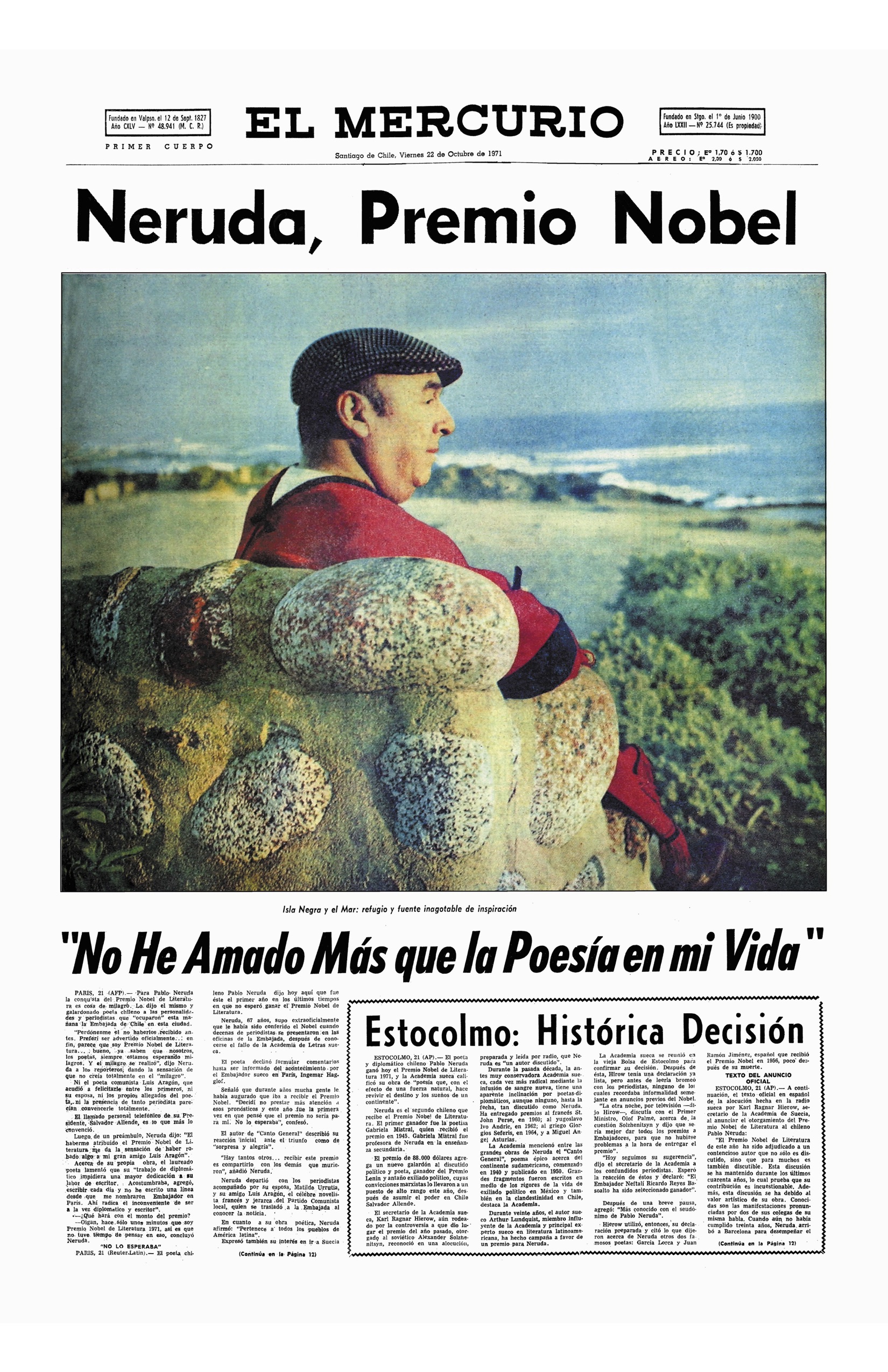
Cover of the newspaper El Mercurio, the most important in the country, with the news of Pablo Neruda, winner of the 1971 Nobel Prize in Literature. Santiago de Chile, Friday October 22, 1971.
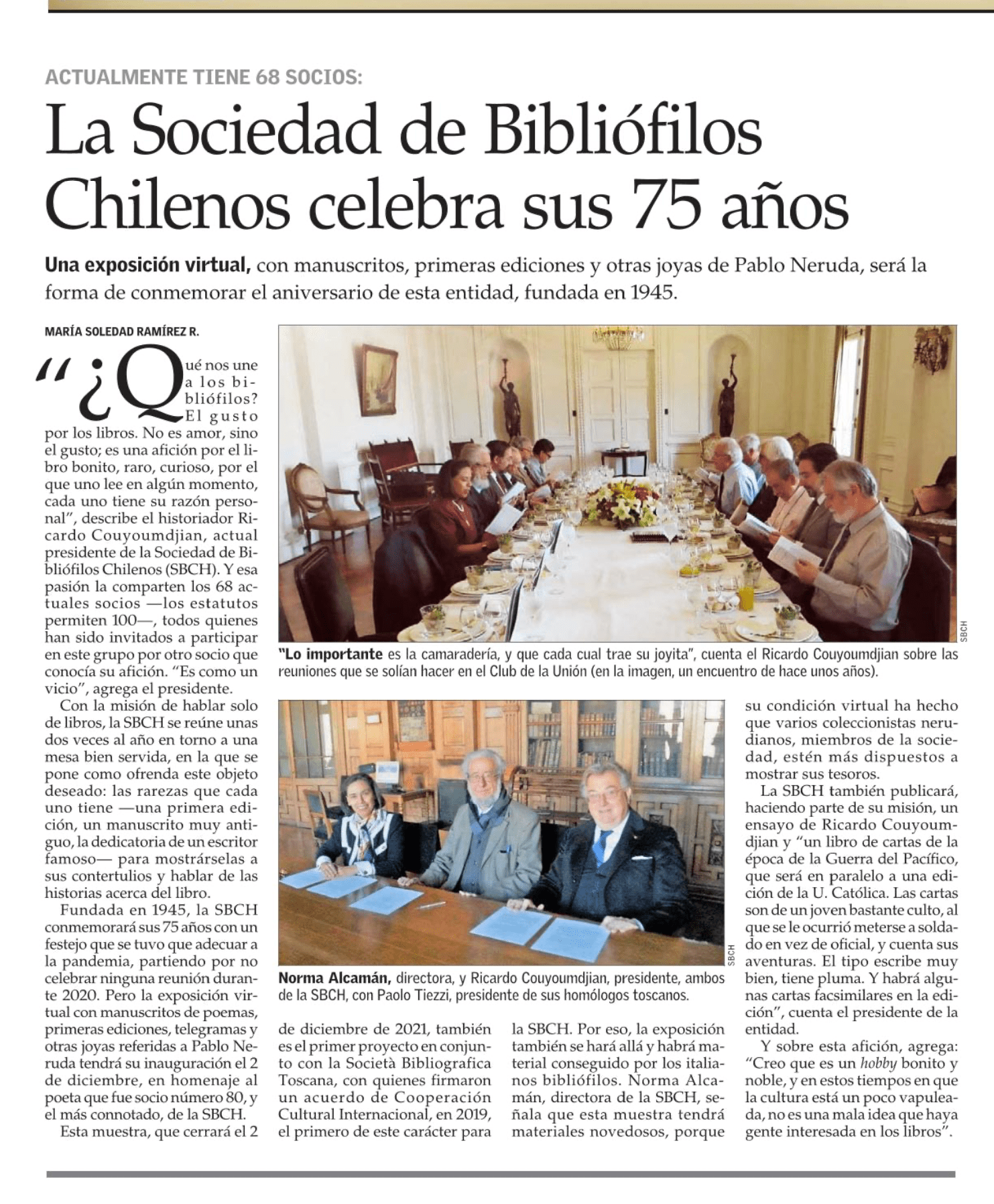
News from El Mercurio, referring to the 75 years of the Chilean Bibliophile Society (1945-2020). Wednesday, August 12, 2020, page A-7.

Journalist and Master in Latin American Studies (University of Chile). Director of the Pablo Neruda Foundation Library.

Writer and diplomat (Antofagasta, 1961). Professor of History and Geography graduated in Diplomacy. Master in International Relations and Doctor in American Studies. Researcher specialized in the biographical dimension of Pablo Neruda with important articles and books published both in national and foreign media. One of them, Allende – Neruda, a friendship, a story, with several editions in Spanish and translated into Italian by Treccani, one of the most prestigious publishers in Italy. A Chinese edition is also in preparation. A British publication has considered it as The world’s leading authority on the letters of Pablo Neruda (Cantalao N ° 1, London, Septembre, 2013).
Video transcription Abraham Quezada
Good afternoon, my friends. From the viceroyalty capital, from Lima, from Peru, I would like to extend an affectionate greeting to the Society of Chilean Bibliophiles and the Tuscan Bibliographic Society of Italy, who have organized this magnificent exhibition, the first Chilean-Italian virtual exhibition “Pablo Neruda: 50 years Nobel Prize in Literature 1971-2021 “. And in that sense, I take the opportunity to greet and also thank the institutions that have contributed to this: the General Historical Archive of the Ministry of Foreign Affairs of Chile stands out, the place where I work, and in Italy, the Library from the Ignazio Cerio Caprense Center, a place that I visited a few years ago.
Undoubtedly, this exhibition is a relevant, extraordinary and, I would say, even endearing exhibition of Neruda, because it shows us the bibliophile Neruda, one of his great passions. Neruda and his collections in Chile and, finally, Neruda in Italy. These three spaces are spaces much loved by the poet and that he developed to the full.
In his role as a bibliophile, for example, I just want to tell you two anecdotes that I had the privilege of bringing to light in some of my published works. One of them is the intense correspondence that the poet carries out with the Chilean academic Claudio Veliz so he can get for him in London an old and very valuable book entitled Travels whose author is Amasa Delano, where in August of 1963 he tells him that he is willing to pay “whatever they ask of him” and in November of that same year, that is to say, a few months later, he adds: “I burn with the desire to see and feel that book.” This was an acquisition that ultimately came to fruition and the poet received the book. When he received it, he held a reception in Isla Negra with all his friends and he was immensely happy.
Another similar anecdote is his desperate and insistent attempts, through his Peruvian friends, to acquire an original copy of Flora Tristán’s book, Peregrinaciones de una Paria, that book from 1838, in its original edition, in French. There were other editions in Chile. Even Ercilla Press, in the 1940s, had published one edition and there were another two more published that the poet could perfectly read. But no, he wanted the original French edition, and why did he want it so much? Because apart from the taste of the old book, of smelling, touching, feeling, as he says in one of his letters, Flora Tristán recounted her passage through Valparaíso and the lies and anecdotes that were circulating in our historic port at that time. Therefore, the poet wanted it in its original edition.
Therefore, this documentary contribution that you are making, with so much care, with so much love, comes, I believe, to justly celebrate Neruda’s intellectual effort and his love for books, while giving an account of his intense poetic world where there is still much to discover.
Luckily for us researchers and scholars, the Neruda`s universe is an expanding universe and the contribution that the Society of Chilean Bibliophiles is making of exposing it very professionally and sharing it, which is the ultimate goal that all people and institutions should have, who are dedicated to it, it is a truly remarkable effort.
If the poet were alive, without a doubt, he would be happy with this initiative, hopefully it will have a second, a third, a fourth and successive versions from now on.
To finish, just a reflection on Neruda and the Nobel Prize.
You well know that Neruda’s Nobel Prize was the second Nobel Prize for Chile and the third for Latin America, after Mistral’s in 1945 and Miguel Ángel Asturias’s in 1967. But Neruda had been a candidate for this recognition since late from the 40s.
In 1964, the poet was deeply moved when he learned of the resignation of the prize that Jean Paul Sartre had made. In the letter that this French philosopher sends to Stockholm, among other arguments, he says “I am not worthy of winning this award until it is given to poets like Neruda.”
Finally, the poet got it. And why did you get it? He got it, without a doubt, because of his talent and his career. But he also got it because of his persistence, because he was tenacious, and he believed and was convinced that he deserved it. So it is with these types of samples, I believe that they account for such a rich expanding universe, I repeat, that Neruda, luckily for all of us, continues to offer us these joys.
Thank you very much for the work done, I send you a warm greeting from Lima. Thank you.
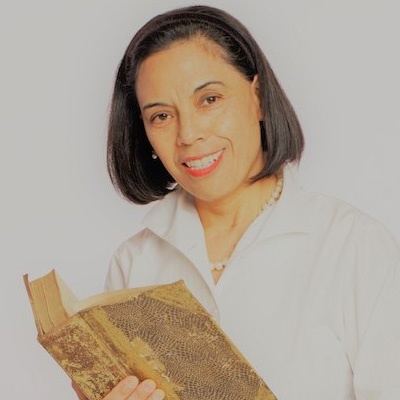
Pablo Neruda, socio número 80 de la Sociedad de Bibliófilos Chilenos, en la cual participó desde sus inicios, fue un bibliófilo en todo el sentido de la palabra. En su biblioteca personal, había más de 11.500 libros, además de cartas, manuscritos de gran valor histórico y cultural, que actualmente se conservan tanto en la Fundación Pablo Neruda, como en la Universidad de Chile, su Alma Mater, donde estudió Pedagogía en Francés y a la cual donó parte de sus colecciones en 1954.
Desde muy joven, fue un ávido lector y buscador de obras literarias antiguas, únicas, raras y valiosas, pasión que se vio facilitada debido a sus numerosos viajes y estadías en diferentes países.
De literatura chilena, poseía un ejemplar de La Araucana, de 1632 (la primera edición, es de 1569). Como sabemos, Neruda además sentía especial predilección por Francia e Italia. Con respecto a obras italianas, tenía una copia de Orlando Furioso, de Ludovico Ariosto, de 1561 (la 1° edición es de 1532) y un ejemplar de La Divina Comedia de Dante Alighieri, del año 1529. Así también, una edición de Triunfos de Petrarca, edición de 1484 (1° ed. original: entre 1351 y 1374. Editio prínceps: Venecia, Vindelino da Spira, 1470). De obras francesas, poseía la Enciclopedia de Diderot y D’Alembert, de 1751. También era propietario de las pruebas de imprenta de Los trabajadores del mar (1866), de Víctor Hugo, con correcciones en los bordes, escritas de puño y letra por su autor.
En referencia a España, país que también era uno de sus predilectos, poseía una edición del Quijote de la Mancha, de 1617. Además, de literatura norteamericana, era dueño de las Obras Completas de Edgar Allan Poe, publicadas en New York, en 1895.
Poco a poco, Neruda formó su amada biblioteca con especial cuidado y dedicación. Era exquisito en los detalles de edición, papel, costuras. Le gustaban los tirajes cortos, como Los Versos del Capitán, con solo 44 ejemplares, porque concebía sus libros en términos de colección. Así también, varios de sus libros unen literatura y pintura, al presentar poemas con obras de Mario Toral de Chile, Guayasamín de Ecuador y Picasso de España. En definitiva, como todo bibliófilo refinado, atesoraba los libros tanto por el valor de las ideas transmitidas, como por la forma. En este sentido, consideraba al libro como un objeto de arte en sí mismo.

Libro incunable. “La palabra incunable (del latín incunabulae, en la cuna) se utiliza para designar a todos los libros impresos en Europa occidental desde que el orfebre alemán Johannes Gensfleisch -más conocido como Johannes Zum Gutemberg (1400-1468)- inventa la imprenta con tipos móviles en Maguncia el año 1440, inspirado en las prensas utilizadas para exprimir uvas en el proceso de elaboración del vino. La denominación “incunable” rige conceptualmente hasta 1501, fecha en que esta tecnología se masificó. Para entonces, en cientos de ciudades europeas había prensas dedicadas a reproducir textos.”

“Pharsalia (también conocida como Bellum civile), es un poema inacabado en diez cantos, el cual narra la guerra civil entre Julio César y Pompeyo, corresponde a un texto escrito en latín por el célebre poeta romano Marco Anneo Lucano (39- 65 d.c). Pertenece a la colección de 5.107 volúmenes donados por el poeta Pablo Neruda el año 1954 a la Universidad de Chile.
Se trata de una epopeya concebida en orden cronológico y considerada un clásico dentro del canon de la literatura antigua.
El libro fue compuesto en el siglo XVI por la imprenta del humanista e impresor italiano Aldus Manutius (1450-1515), quien fuera reconocido como el más grande tipógrafo de su tiempo, por haber dado forma a criterios importantes de edición, tales como la puntuación, la invención del punto y coma, de los caracteres cursivos, la numeración de las páginas y el formato en octavo.”

“Edición en pequeño formato de la obra del poeta Dante Alighieri (c. 1265-1321), publicada en italiano, en la ciudad de Florencia el año 1915. Fue compuesta por G. C Sansoni Editore. Incluye antecedentes biográficos del autor y anotaciones página a página. Pertenece a la Colección donada en 1954 por Pablo Neruda a la Universidad de Chile, conjunto que fue declarado Monumento Histórico Nacional en 2009.”
![Víctor Hugo, Les travailleurs de la mer [maquette], Librairie Internationale A. Lacroix, Verboeckhoven et C. Editeurs, Paris, 1866, 2 vólumenes.](https://pabloneruda.bibliofilos.cl/wp-content/uploads/2020/10/thumb-3.jpg)
“Pruebas de imprenta de la primera edición del libro Les travailleurs de la mer, texto escrito por Víctor Hugo (1802- 1885), poeta, novelista y dramaturgo francés considerado como uno de los mayores exponentes literarios del siglo XIX. “

Nouveau langage des fleurs es un libro único en Chile. “El texto, sin autor preciso, tiene tres objetivos: identificar conceptualmente el lenguaje existente de manera implícita en cada una de las flores ordenadas por tipos y nomenclaturas precisas; interpretar el valor simbólico de las mismas; y ejemplificar el uso literario, novelesco y poético que las flores han tenido, considerando el trabajo de múltiples escritores europeos, entre los que se encuentra el eminente Honoré de Balzac. Al final del libro encontramos poesías y narraciones al respecto.”
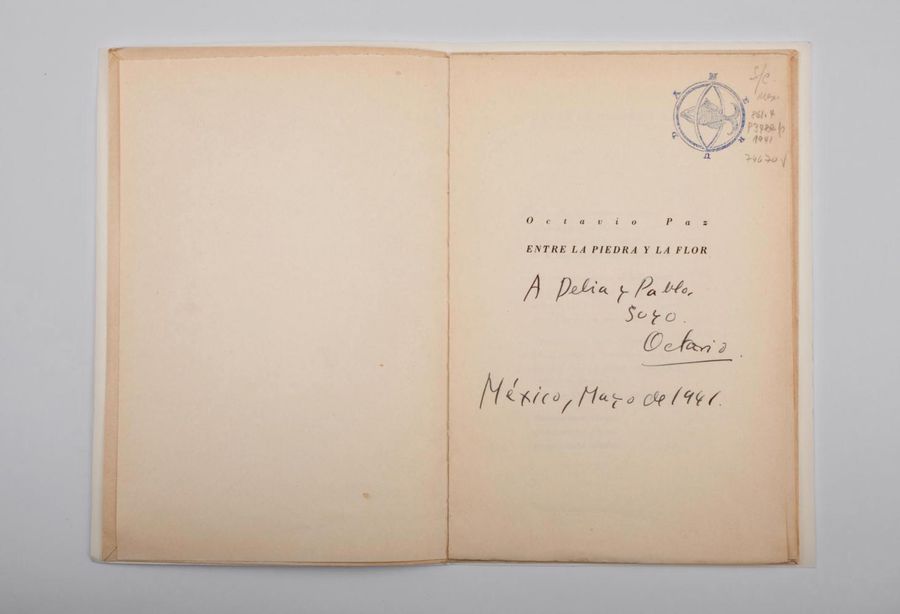
“Libro editado por el sello mexicano Nueva Voz en 1941, dedicado por su autor a Pablo Neruda y a su entonces esposa Delia del Carril el mismo año de la publicación. Octavio Paz (1914-1998), poeta, ensayista, traductor y destacado intelectual mexicano trabó amistad con Pablo Neruda en el contexto del II Congreso Internacional de Escritores en Defensa de la Cultura, España, 1937.” Más tarde, en 1990, Octavio Paz obtuvo el Premio Nobel de Literatura.

Lawyer. Partner of the Chilean Bibliophile Society.
My name is Franco Brzovic, a member of number of the Society of Chilean bibliophiles. I am pleased to tell you about an interesting book by Neruda titled “All the Love”, which is a personal anthology. It is a first edition that also has some special characteristics. In this document, you will be able to appreciate the letter by the author in which he entrusts Guiseppe Bellini to edit this book in 1968, in Spanish and Italian. The book, unlike some others, has retained the first page and the dedication page. The book was acquired in Catania, Sicily, some time ago after I toured numerous bookstores.
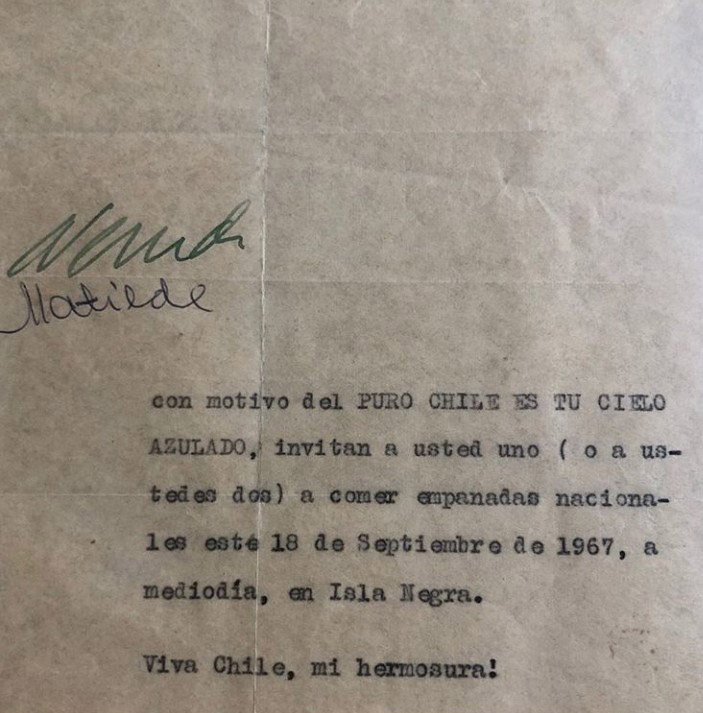

Degree in History and Master in History and Management of Cultural Heritage. Director of the Historical Archive of the Ministry of Foreign Affairs of Chile.
Interview
When was the Historical Archive of the Ministry of Foreign Affairs created and what are its objectives?
The Ministry of Foreign Relations was created in 1871 and the first record of the operation of its archive is a circular dated November 23, 1901, which aims to organise the internal system of archives.
Later provisions separated the Historic Archive from the Registry Office and designated it as the General Historical Archive, with the sole function of preserving and ordering all the documents of the Chancellery. At present, the archive is a Department that depends on the Undersecretariat of the Ministry of Foreign Affairs, whose structure and objectives have become more complex.
Nowadays, its main functions are related to an integral archival management and its main objectives are focused on describing, preserving, and giving access, according to international and national standards, to the documentation originated and received by this Ministry. In addition, his function is to contribute to the transparency of information by attending to requests for transparency and inquiries from users, both in person and by email. This has become an important part of the work of our archive.
The main topics that can be investigated from our documents are diplomatic and consular management, bilateral relations with neighbouring countries, colonization and immigration, foreign trade, participation in international organizations and institutional history itself, among others.
What emblematic projects have you carried out in the Historical Archive?
Since 1994, the General Historical Archive has carried out important projects that have been financed with private or state funds, which have focused mainly on the organization, description and cataloguing of some of our documents collections, and on digitization and conservation of photographs belonging to our photographic archive.
• During 1994 and 1995, the Project for the Installation and Equipment of the Conservation Laboratory Restoration of the Paper Laboratory was carried out, with funds provided by Fundación Andes.
• Between 1998 and 2002, the Border Countries Archive Conservation and Cataloguing Project was carried out.
• In 2005 the Conservation and Cataloguing Project of the Photographic Collection of the Chancellery was carried out, with funds contributed by Harvard University.
• Between 2012 and 2013, 3,500 photographs were digitized for displaying the Photographic Archive in our catalogue on the website, which was financed by the Heritage Trust Project of the EMC Company.
• Between 2014 and 2016, the project “Enhancement of the Immigration Fund: Organization, Assessment and Description of Documentation” was carried out, stages 1 and 2, with funds from RADI.
• Between 2018 and 2020, the two phases of the project “Cataloguing the International Organizations Fund: First Stage (1983 – 1990) and Second Stage (1990 – 1992)” were carried out, also with funds contributed from RADI.
• Between 2019 and 2020, thanks to funds granted by RADI, the project “Conservation and Digitization of the Albums of the Chilean Chancellery Archive” was executed.
The photos of Neruda from the trip to the USSR, what year are they and for what reason?
The photographs of Pablo Neruda in the USSR correspond to a trip carried out in 1950 from Mexico, aboard the “steam Argentina”, which made a brief stop in Cuba.
In Moscow, he attended a meeting with communist representatives from around the world, in which was discussed the organization of a communist resistance army in each of the Latin American countries.
What were the diplomatic positions held by Pablo Neruda?
Starting his first diplomatic stage, Pablo Neruda was appointed in 1927 as Consul of Chile in Rangoon, Burma. In the period from that year to 1933, he also served as Consul in Colombo, Batavia and Buenos Aires.
In 1934 he assumed the position of Consul of Chile in Barcelona and the following year in Madrid. The outbreak of the Spanish Civil War in 1936 meant a hiatus in his diplomatic work, causing his return to Chile in 1937.
In 1939 he settled as Consul of Chile in Paris, from where he managed one of his greatest contributions as a representative of our country abroad. He organised the Winnipeg ship trip, which brought more than 2,000 Spaniards who chose Chile as the country of asylum.
Finally, in 1940 he was assigned as Consul to Mexico and between March 1971 and the end of 1972 he served as Ambassador in Paris.
1927: Consul of Rangoon, Burma.
1930: Consul in Batavia, Java.
1933: Consul in Buenos Aires, Argentina.
1934: Consul in Barcelona, Spain.
1935: Consul in Madrid, Spain.
1939: Consul in Paris, France, for Spanish immigration.
1940-1943: Consul in Mexico City.
1971-1972: Ambassador to Paris, France.

Doctor of Literature. Professor, University of Chile. Poet.
Reading of a fragment of “Heights of Machu Picchu”
Good afternoon, here I am with the first edition of Song of the Americas, edited by Edición América. It is not the first, but the first edition at least in Chile. And I want to read you a fragment of “Heights of Machu Picchu” written by our great Pablo Neruda and comment on, at least, some of the most important things that in my view are in the text.
The first thing I would like to say before reading it is about the position of the speaker. The speaker or the poet expresses himself in a way of saying things so that he resembles the voice of America. In some way, it is the wonder of being the prophet poet, the Promethean poet, that somehow it tells us that he foresees the future of our America.
Obviously, I am not going to read this text in full, but it links, let us put it this way, the concept of being, and as it says in a verse: the great poet or the great speaker or the great voice that comes to speak through your dead mouth.
Obviously, these verses that were musicalized by “Los Jaivas”, are verses that, in the tone of a song or Venezuelan rhythm, immediately come to our ears:
Arise with me, American love.
Arise to birth with me, my brother.
Give me your hand out of the depths
sown by your sorrows.
You will not return from these stone fastnesses.
You will not emerge from subterranean time.
But I would like to stop at another text that, perhaps, people do not remember as so crucial within this same poem. I am referring to part IX, the fragment IX of this wonderful text, which I insist, comes to take the entire American origin and link it with our own current destiny. I am referring to this text, which I want to highlight and underline, that uses the adjective and the noun in an extraordinary way.
Listen to a wonderful fragment of the “Heights of Machu Picchu”:
Sidereal eagle, vineyard of mist.
Bulwark lost, blind scimitar.
Starred belt, sacred bread.
Torrential ladder, giant eyelid.
Triangled tunic, pollen of stone.
Granite lamp, bread of stone,
Mineral serpent, rose of stone.
Buried ship, wellspring of stone.
Lunar horse, light of stone.
Equinox square, vapor of stone.
Final geometry, book of stone.
Iceberg carved by the squalls.
Coral of sunken time.
Rampart smoothed by fingers.
Rood struck by feathers.
Branching of mirrors, ground of tempests.
Thrones overturned by twining weeds.
Rule of ravenous claw.
Gale sustained on the slope.
Immobile turquoise cataract.
Sleepers’ patriarchal bell.
Collar of subjected snows,
Iron lying on its statues.
Inaccessible storm sealed off.
Puma hands, bloodthirsty rock.
Shading tower, dispute of snow.
Night raised in fingers and roots.
Window in the mist, hardened dove.
Nocturnal plant, statue of thunder.
Root of the cordillera, roof of the sea.
Architecture of lost eagles.
Cord of the sky, bee of the heights.
Bloodstained level, constructed star.
Mineral bubble, moon of quartz.
Andean serpent, brow of amaranth.
Dome of silence, purebred homeland.
Bride of the sea, cathedral tree.
Salt branch, blackwinged cherry tree.
Snowswept teeth, cold thunder.
Scraped moon, menacing stone.
Crest of the cold, pull of the air.
Volcano of hands, dark cataract.
Silver wave, direction of time.
(This poem was translated by John Felstiner in Translating Neruda: The Way to Macchu Picchu, John Felstiner, Stanford University Press, 1980).
I believe that this small fragment, fragment IX of the Canto General is, without a doubt, one of the finest proofs that a poet can provide of greatness.
I believe, as Pablo Neruda – who was “the enemy” of Vicente Huidobro – said the adjective kills when it does not give life. And here, precisely, is where the adjective gives the greatest life and builds, through the word, a universe that may be lost, but that returns to us in one way or another.
Third Residence Reading (1947)
How are you? Perhaps this is one of Pablo Neruda’s texts that most stirs the conscience of all of us, as it is a text that implies the change from the surrealist writing to the socialist realism writing style. It happens without falling excessively to the communist or the partisan side.
In this book, Neruda draws our attention to the tragedy of a war, the tragedy of the Spanish Civil War. A war that, without a doubt, has a profound significance for me, given that I am the son of one of the exiles who arrived on the ship Winnipeg. This was possible thanks to Pablo Neruda, the Government of Pedro Aguirre Cerda and the government of the Spanish Republic in exile.
And this poem, which many of you probably know, shows why his poetry changes, why he no longer writes in surrealist or in the avant-garde style. He moves forward, explores the condition of the people, the condition of suffering the wounds of the pain of others. The poem is part of “Third Residence”. Here I have the first edition “Editorial Losada” from 1947 and the fragment that I am going to read from this book, which is Spain in the Heart, the great poem that he writes about the Civil War, is the fragment “I explain some things”.
You are going to ask: and where are the lilacs?
and the poppy-petalled metaphysics?
and the rain repeatedly spattering
its words and drilling them full
of apertures and birds?’
I’ll tell you all the news.
I lived in a suburb,
a suburb of Madrid, with bells,
and clocks and trees.
From there you could look out
Over Castille’s dry face:
a leather ocean.
My house was called
the house of flowers, because in every cranny
geraniums burst: it was
a good-looking house
with its dogs and children.
Remember, Raúl?
Eh, Rafael?
Federico, do you remember
from under the ground
where the light of June drowned flowers in your mouth?
Brother, my brother!
Everything
loud with big voices, the salt of merchandises,
pile-ups of palpitating bread,
the stalls of my suburb of Argüelles with its statue
Like a drained inkwell in a swirl of hake:
oil flowed into spoons,
a deep baying
of feet and hands swelled in the streets,
metres, litres, the sharp
measure of life,
stacked-up fish,
the texture of roofs with a cold sun in which
the weather vane falters,
the fine, frenzied ivory of potatoes,
wave on wave of tomatoes rolling down to the sea.
And one morning all that was burning,
one morning the bonfires
leapt out of the earth
devouring human beings –
and from then on fire,
gunpowder from then on,
and from then on blood.
Bandits with planes and Moors,
Bandits with finger-rings and duchesses,
Bandits with black friars spattering blessings
came through the sky to kill children
and the blood of children ran through the streets
without fuss, like children’s blood.
Jackals that the jackals would despise,
stones that the dry thistle would bite on and spit out,
vipers that the vipers would abominate!
Face to face with you I have seen the blood
of Spain tower like a tide
to drown you in one wave
of pride and knives!
Treacherous
generals:
see my dead house,
look at broken Spain:
from every house burning metal flows
instead of flowers,
from every socket of Spain
Spain emerges
and from every dead child a rifle with eyes,
and from every crime bullets are born
which will one day find
the bull’s eye of your hearts.
And you will ask: why doesn’t his poetry
speak of dreams and leaves
and the great volcanoes of his native land?
Come and see the blood in the streets.
Come and see
the blood in the streets.
Come and see the blood
in the streets!
(This poem was translated by Nathaniel Tarn. From: Pablo Neruda Selected Poems: A Bilingual Edition, Houghton Mifflin / Seymour Lawrence, Boston, 1970)
This extraordinary poem by Neruda evokes the terrible tragedy that can touch us at any moment: Syria, Lebanon, Libya. Any place in the world can be the terrible place where we lose our children, where we lose the blood of our fellow men, where our home is destroyed. That is why the poet changes his style, changes his form, changes his saying to also enter once more into the absolute convulsion of deepest humanity. The terrible tragedy and the wonderful joy of being human.

Economist, academic, writer and member of the Chilean Bibliophile Society.
Obras Completas

Colección de las Obras Completas, publicadas por la Editorial Cruz del Sur, en 10 volúmenes muy pequeños en 1947. Se distribuyó por suscripción a un número limitado de personas (casi todos norteamericanos y europeos, muy pocos chilenos) y nunca salió a la venta en librerías.

Arriba, a la izquierda: primera edición de Canto General, Talleres Gráficos de la Nación, Ciudad de México, 1950.
Arriba, a la derecha: primera edición de Las Uvas y el Viento. Editorial Nascimento, Santiago de Chile, 1954.
Abajo, se puede apreciar el pequeño tamaño de las Obras Completas

Cada ejemplar de esta colección fue autografiado por Pablo Neruda, con su característica tinta verde.

Norma Alcamán Riffo, Bachelor in Literature and Master in Literature. Diploma in Cultural Administration. Writer.
Director of the Society of Chilean Bibliophiles and Member of the Società Bibliografica Toscana, in Italy. Director of this virtual exhibition.
Splendor and death of Joaquín Murieta (1967): Neruda’s only dramatic work.
When a prominent person is commemorated, especially if he is a great writer, painter or musician, various activities are usually carried out and his work is reconsidered from new perspectives, which shed new light on his understanding and update his contribution to a discipline. Accordingly, the commemoration of the 50th anniversary of the Nobel Prize for Literature conferred to Pablo Neruda in 1971 is an invitation to reread, study and analyse his work, and to value those parts that merit it.
In the context of the extensive creation of Neruda’s, The Splendour and Death of Joaquin Murieta is particularly interesting: it is a dramatic work which has versions in theatre and opera. Pablo Neruda defined it as follows: “This is a tragic work, but also, in part, it is written as a joke. It would like to be a melodrama, an opera and a pantomime”. Although it is understandable that the study of his extensive and profound poetic work occupies almost all the academic articles and books dedicated to his literary creation, it is also fair to take this particular work into consideration as well.
In 1966, Pablo Neruda published this only dramatic work with Editorial Zig-Zag, which launched its first edition with 10,000 copies, of which my parents – great readers – acquired number 7,076, which they kept in their library. In 1967, it was presented as a theatrical work for the first time at the Antonio Varas Theatre. Then, Neruda commissioned the music by the composer Sergio Ortega, who worked developing the aesthetic ideas of the text. As an opera, it was premiered at the Municipal Theatre of Santiago in 1998.
The play, set in 1850 during the gold rush, begins in Valparaíso when Joaquín Murieta embarks for California, seeking a better future. On the way, he marries Teresa, a Chilean from the countryside. It is a love match, so the couple legitimately wants to start a family. However, upon reaching California, the “greyhounds” (North Americans) rape and kill Teresa. This experience causes unfathomable pain in Joaquín Murieta, who responds with fury, transforming himself into a famous bandit motivated by revenge, until he is killed.
From a dramatic perspective, first, we note that it is a work that responds to the traditional structure proposed by Aristotle in Poetics, so that its aesthetic codes (unity of action, presence of incidents, anagnorisis, etc.), are readable by an international educated public.
When studying the work with the method of analysis of dramatic situations, established by Etienne Souriau in Le 200.000 situations dramatiques, it fully responds with the oriented force, the object desired, desired subject, opponent, assistant, and referee, that is, the six abstract forces that participate in the dramatic tension which is resolved at the end, immediately after the climax.
Second, we address the level of symbols and motifs. As for the symbols, the sea is the main one, which is complemented by the ship. In this journey, which is a symbol of life, we find a gallery of diverse characters.
Regarding the literary motifs, as we know, they have two meanings: as elements that move the dramatic action (since the motive comes from the Latin muovere) and also as recurring elements of the play. Now, in this particular case, in its first sense, we find love, greed, destiny and, in its second sense, we find travel, friendship, and revenge. These and other elements are intertwined in such a way around a central axis, which ultimately determines the theme: the eternal struggle of good and evil, which are present throughout the whole story.
Third, the litmus test of any literary work is time. In this case, it is still valid in the tradition -innovation duality. Indeed, our poet and his playwright bring together elements of Greek theatre, such as the presence and role of the choir within the dramatic structure, as well as the tragic destiny of the protagonist and qualifies it with elements of the Noh theatre that he saw in Yokohama; all of this, set on the ship and later in the city of San Francisco, California in 1850. Certainly, the result is original and well achieved. More than 50 years have passed; however, this piece is still full of meaning, maintains its liveliness and carries an ever-living message.
Based on the foregoing, we can assert that Neruda’s only dramatic work, has several levels of meaning: literal, symbolic and mythical, because by turning Joaquín Murieta into a tragic hero and elevating him to the category of Chilean myth, placed it in an abstract and perennial setting.
This play is key to establishing that Neruda was a complete writer, as he cultivated the lyrical, narrative and dramatic genres, always with different nuances, talent and great sensitivity. He also possessed knowledge of the literary tradition and knew how to update it with his vision, which allowed him to be part of the pantheon of world literature.
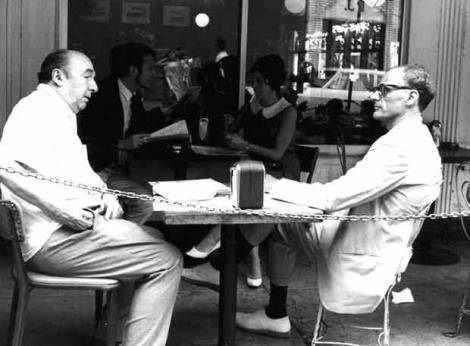









Pablo Neruda con el dramaturgo norteamericano Arthur Miller (New York, 1966).



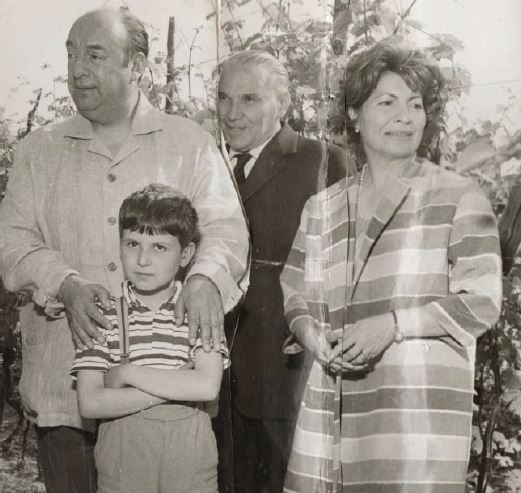

Pablo Neruda with the playwright Arthur Miller (New York, 1966).
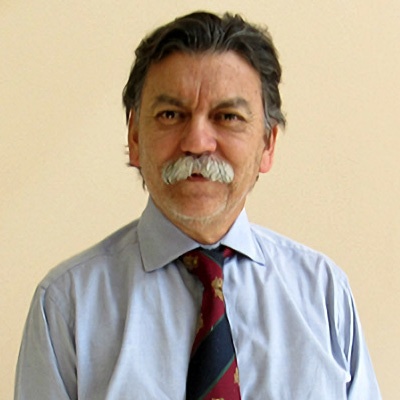
Gynecologist-obstetrician. Partner of the Chilean Bibliophile Society.
Edgardo Corral was born in 1954 in Rancagua, 10 kilometres south of Santiago. He is a gynaecological obstetrician, a specialist in foetal medicine. Currently, he is the Head of the GO Service and has been directing an intrauterine surgery program since 2012 at the Rancagua Hospital. He has published several articles in different international magazines, and he is the author of a couple of chapters in books on the area. He is also an academic at the Diego Portales University School of Medicine.
Edgardo grew up in the province and when he was a teenage student, he had the privilege of meeting Neruda personally, when Neruda visited his Lyceum around 1970. On that memorable day, his interest in Neruda’s universe was born, which he approached through an avid reading of his best known poetry. Later, he studied both the biography and the complete work of the poet, becoming a true cultist of Neruda.
Later, with time and travel, he realized that Neruda is the most universal character that Chile has. This was another motivation to passionately search for any document or memory that is related to his life and work. This is how, to this day, he is a recognized collector of first editions, letters, and some handwritten pieces by Neruda. In addition, he has dedicated himself to research and writing articles on unknown, but important, topics that belong to Neruda’s life. Among others, he published in the magazine of the Neruda Foundation a scientific analysis on the birth in Madrid of Neruda’s only daughter, Malva Marina. He also participated together with the Mayor, in the inauguration of Pablo Neruda Street in Saint-Avertin near Paris and he is working on a draft describing the friendly relationship between Neruda and Baltazar Castro, a politician and writer from Rancagua, his hometown.
Volodia Teiltelboim: friend, comrade and fellow poet
Volodia Teitelboim was a lawyer and an important Chilean politician during the 20th century. In addition, he stood out as a writer. He was part of the group known as The Literary Generation of 1938, and he received the National Prize for Literature in 2002. In this context, he was one of Pablo Neruda’s greatest friends, from 1937 until the poet’s death in 1973, and they were partners in political struggles and colleagues in the field of letters.
Volodia Teitelboim was born in Chillan in Chile in 1916, the same year that Rubén Darío died. During the 1930s, he participated as part of the revolutionary movement in art and socialism. He entered the Communist Youth Party and studied law at the University of Chile without losing his passion for poetry. In 1935, with Eduardo Anguita, he published the Anthology of New Chilean Poetry, a book that caused a long controversy, because it did not include Gabriela Mistral or other important writers.
In 1952, Teitelboim published Sons of Nitrate with a foreword by Neruda in the second edition, after which came difficult days including an exile to Pisagua in the north of Chile in 1956. In the 1960s, he was a member of parliament in the low chamber and later Senator for Valparaíso. In the political world, he was recognized for his eloquence and oratory. At the beginning of the ’70s, the Nascimento Press published a little-known book, The Trade of a Citizen, where Neruda once again wrote a foreword for him with true devotion to his qualities as a committed intellectual, and generating, according to Neruda, “a new dimension of politics”. Then came self-imposed exile in Moscow. Upon his return to the country after 15 years, he published during the ’80s and’ 90s biographies of Neruda, Mistral, Borges and Huidobro, written with great literary rigour.
His biography about Pablo Neruda is one of the most complete and unique, since in it he manages to reveal the poet in his human aspect. This book brings the virtues of a chronological essay, although it indicates that the true biography of Neruda is in his poetry, where he captured all the calls of life.
SIEMPRE
Antes de mí
no tengo celos.
Ven con un hombre
a la espalda,
ven con cien hombres en tu cabellera,
ven con mil hombres entre tu pecho y tus pies,
ven como un río
lleno de ahogados
que encuentra el mar furioso,
la espuma eterna, el tiempo!
Tráelos todos
adonde yo te espero:
siempre estaremos solos,
siempre estaremos tú y yo
solos sobre la tierra
para comenzar la vida!
Pablo Neruda
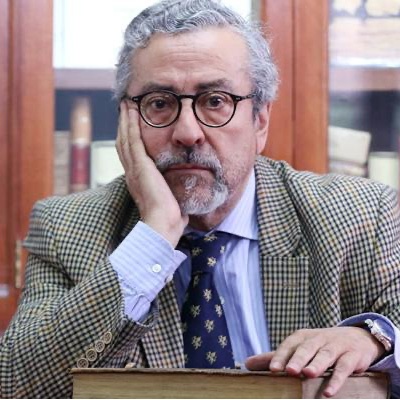
Poet. Partner of the Chilean Bibliophile Society.

Part of his Nerudian collection is contained in this book:
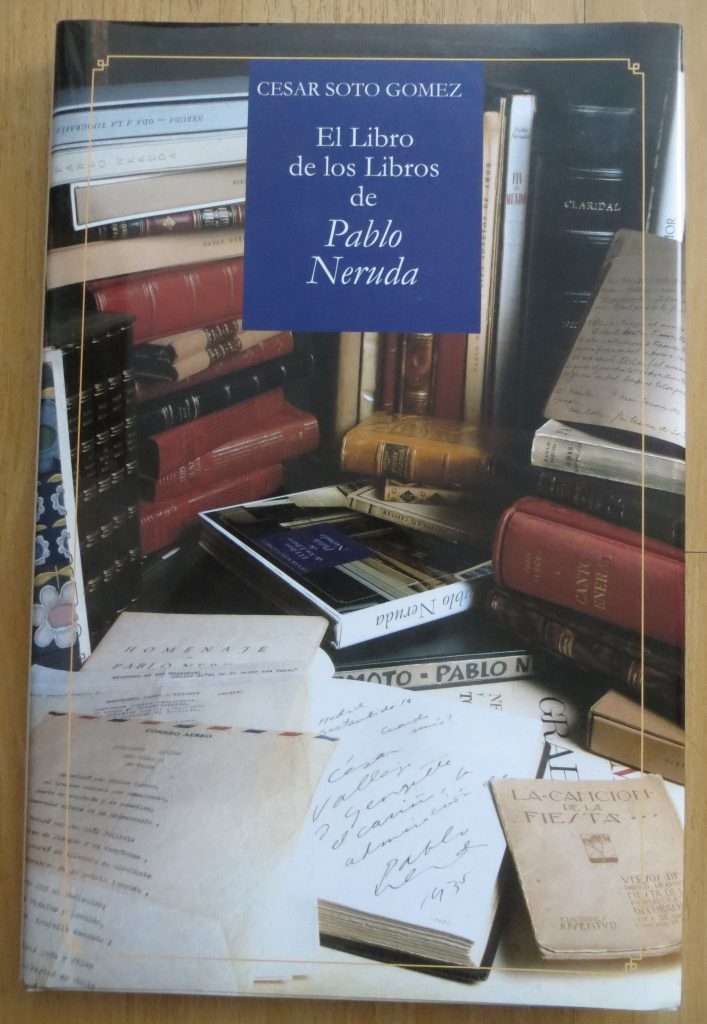
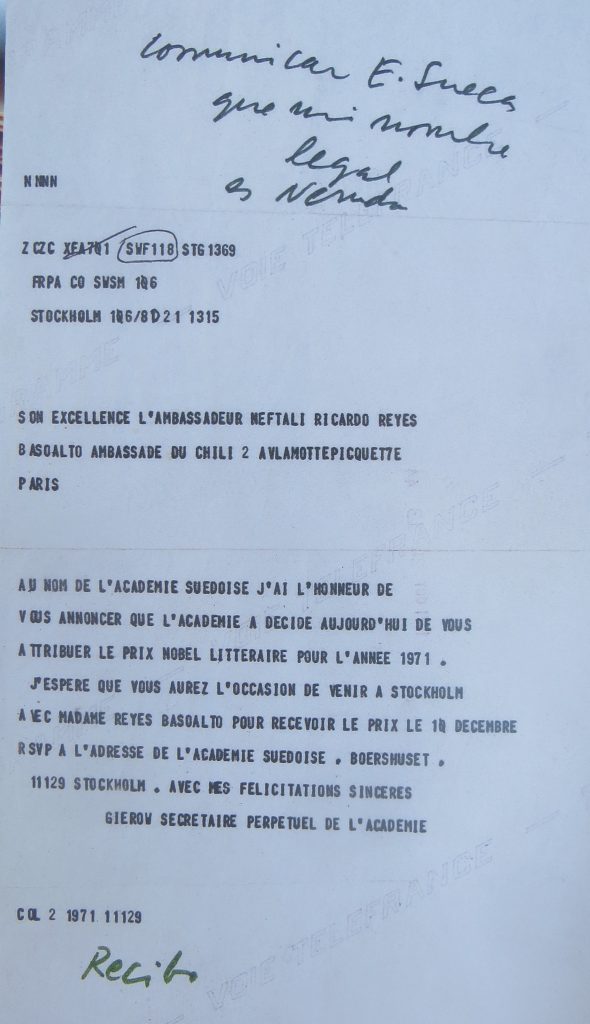
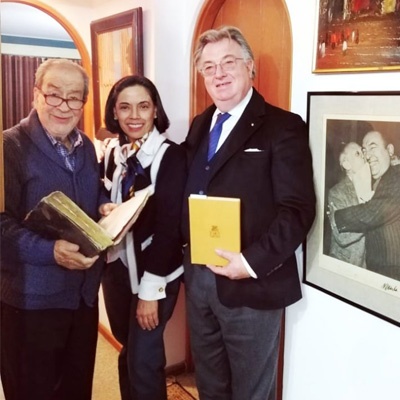
The lawyer Nurieldín Hermosilla, a member of the Society of Chilean Bibliophiles, receives at his home a visit from Norma Alcamán Riffo and Paolo Tiezzi Mazzoni della Stella Maestri, President of the Società Bibliografica Toscana. Next to them, the photo of Picasso and Neruda in a friendly

The Book of Leaves, a unique hand-made copy.
“The Book of Leaves
by Pablo Neruda
Paris
November 1971
Unique specimen made for Ugne Karvelis.”
“The leaves are falling
from a
forgotten autumn.
Falling towards the
abyss of the
light.”


Ignacio Swett is a Civil Engineer and is currently a member of the Board of Directors of a steel company and of the Puente Foundation, which aims to help vulnerable young people. As a bibliophile, he is a recognized collector of first editions of Chilean history, of Gabriela Mistral (Nobel Prize in Literature 1945) and Pablo Neruda.
Video subtitled in Spanish and Italian
Vídeo subtitulado en español e italiano
In 1998, I received a telephone call from a person who knew about my bibliographic hobbies and about my interest for first editions of Pablo Neruda’s work. He told me he had a book that he thought might interest me because it was signed by Neruda and because in the colophon, it was established that the edition consisted of only 10 copies.
This person took it to my office and as soon as I saw it, I knew I would buy that copy. It was a book entitled Two Poems, of which I had no reference whatsoever.
I acquired the aforementioned book and, as soon as I could, I went to the Neruda Foundation to request information on those “Two Poems”. Talking to Tamara Waldspurger I learned the story that I comment on below.
The penultimate work of Pablo Neruda, published during the poet’s lifetime, was “Four Poems Written in France”. This work, as its name implies, consists of four poems, namely: The Ocean is Calling; Homer Arrived; The Bell Tower of Authenay and The Skin of the Birch.
As Neruda himself says in a “declaratory note” at the end of the book, these and other poems were written in 1972, during his car trips between the Chilean Embassy building and his house in Condé-Sur-Iton, in French Normandy.
The colophon of this work says verbatim:
“This work consists of 300 numbered copies, the first 100 from I to C, printed on special feather paper with a fantasy paper cover, plus 200 copies numbered from 101 to 300 on special feather paper with a printed cardboard cover. All copies bear the signature of the author. The printing was made in the workshops of Editorial Nascimento and finished on December 31, 1972 “
When this book was published, one of the printing workers took the first and the fourth of the aforementioned poems and, without the authorization or knowledge of the author, proceeded to print a book that he called “Two Poems.” This book consists of twenty-four unnumbered pages, where only the odd or right-hand pages are used, and has the same typeface and layout and the same printing date as the book “Four Poems Written in France”.
“This work consists of 300 numbered copies, the first 100 from I to C, printed on special feather paper with a fantasy paper cover, plus 200 copies numbered from 101 to 300 on special feather paper with a printed cardboard cover. All copies bear the signature of the author. The printing was made in the workshops of Editorial Nascimento and finished on December 31, 1972 “
When this book was published, one of the printing workers took the first and the fourth of the aforementioned poems and, without the authorization or knowledge of the author, proceeded to print a book that he called “Two Poems.” This book consists of twenty-four unnumbered pages, where only the odd or right-hand pages are used, and has the same typeface and layout and the same printing date as the book “Four Poems Written in France”.
“Esta edición consta de 10 ejemplares, impresos en cartón prensado, numerados de la letra A a la J y firmados por el autor. La impresión fue hecha en los talleres de la Editorial Nascimento y terminada el 31 de diciembre de 1972”
El operario que hizo estos 10 ejemplares fue un día a Isla Negra y le presentó a Pablo Neruda el resultado de “su atrevimiento”. Dicen que al poeta no le pareció bien el proceder de este operario pero que, finalmente, se rindió ante esta osadía y firmó los diez ejemplares que le presentó el personaje en cuestión.
No se sabe si Neruda se quedó con algún o algunos de estos ejemplares, aunque lo más probable es que así fuera, ni quienes puedan ser – actualmente – los poseedores o dueños de los restantes. El ejemplar de “Dos poemas” que cayó en mis manos es el Ejemplar letra J de esta particular y poco conocida edición.
Cabe hacer mención que “Dos poemas” no aparece mencionado en la bibliografía de Neruda hecha por Horacio J. Becco, la que incluyó “Cuatro poemas escritos en Francia”. En las Obras Completas editadas por Hernán Loyola no se menciona la obra “Cuatro poemas escritos en Francia” y, por lo tanto, tampoco se hace mención a “Dos poemas”.
It is also worth mentioning that of the poems in the book “Four Poems Written in France”, only the one entitled “The Bell Tower of Authenay” was published before the aforementioned book. Indeed, it appears in “Unfruitful Geography”, a book published in Buenos Aires by Editorial Losada, printed in May 1972.
The poems “The Skin of the Birch” and “Flame the Ocean” were included in the work “Winter Garden”, published in Buenos Aires by Editorial Losada, printed on January 8, 1974.
Finally, the poem “Homer Arrived” was included in the book “Chosen Defects”, also published in Buenos Aires by Editorial Losada and was printed on July 28, 1974.

Enrique is an architect and a writer. He is currently the Director of the Society of Chilean Bibliophiles and is also a music producer. In Chile, he has produced “My Fair Lady”, “Cabaret”, “The Sound of Music”, “Chicago”, “Cats” and “A Chorus Line”. In 2008, thanks to his management, Ennio Morricone performed for the first time in Chile with huge success, accompanied by the Symphony Orchestra of Rome and he also performed with the Choir of the University of Chile. Enrique is the First Vice President of the Pablo Neruda Foundation and a collector of his work, and during his youth he met the poet.
Vídeo subtitulado en español e italiano








Italian singer-songwriter, very loved by the Chilean public. He won the popular music competition at the LVI Viña del Mar International Song Festival in 2015.
Poem 20
Hello friends, I am Franco Simone and I am a singer-songwriter, but I am also a huge admirer of Pablo Neruda’s poetry. In addition, I would add that Pablo Neruda is, absolutely, my favourite poet.
Exactly 50 years have passed since the Nobel Prize was awarded to this great poet. I invite you all to visit the Italo-Chilean virtual exhibition “Pablo Neruda: 50 Years of the Nobel Prize in Literature (1971-2021)”.
What would you say about this poet? I have always admired his originality, his great spirituality, which became something carnal. He always knew how to unite spirit with eroticism. At times, he seemed not very modest, but without ever being indecent or transgressive. There is always something to learn when reading Neruda. Today I wanted to read some verses from his beautiful Poem 20:
Tonight I can write the saddest lines.
Write, for example,’ The night is shattered
and the blue stars shiver in the distance.’
The night wind revolves in the sky and sings.
Tonight I can write the saddest lines.
I loved her, and sometimes she loved me too.
Through nights like this one I held her in my arms
I kissed her again and again under the endless sky.
She loved me sometimes, and I loved her too.
How could one not have loved her great still eyes.
Tonight I can write the saddest lines.
To think that I do not have her. To feel that I have lost her.
To hear the immense night, still more immense without her.
And the verse falls to the soul like dew to the pasture.
What does it matter that my love could not keep her.
The night is shattered and she is not with me.
This is all. In the distance someone is singing. In the distance.
My soul is not satisfied that it has lost her.
My sight searches for her as though to go to her.
My heart looks for her, and she is not with me.
The same night whitening the same trees.
We, of that time, are no longer the same.
I no longer love her, that’s certain, but how I loved her.
My voice tried to find the wind to touch her hearing.
Another’s. She will be another’s. Like my kisses before.
This is Pablo Neruda
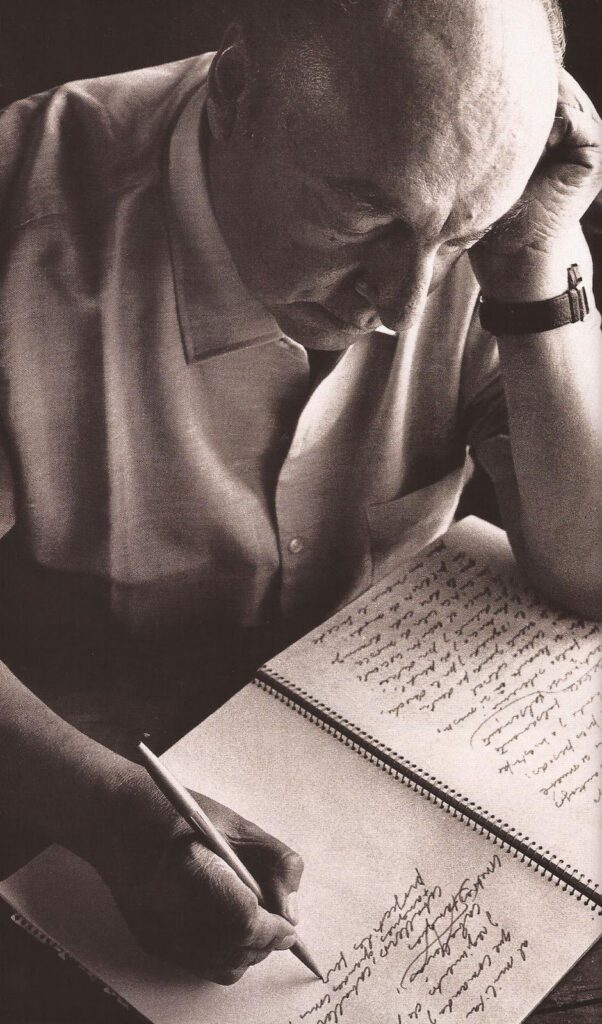
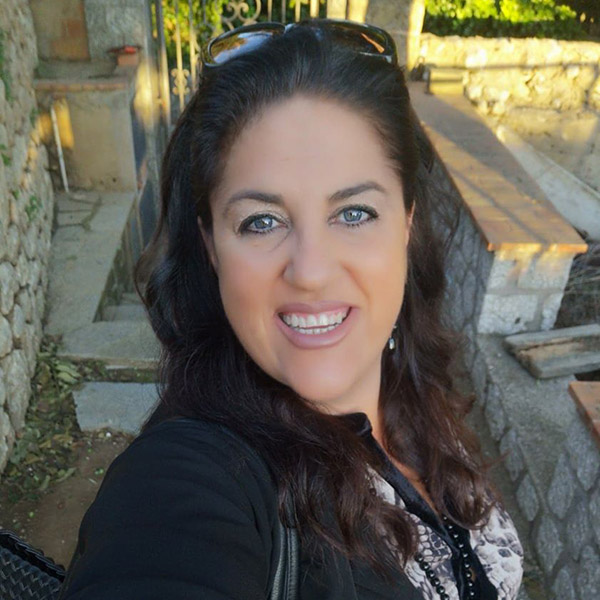
Poet from Capri, Italy.
Annalena is a poet who was born in and lives in Capri. She has always been passionate about art and literature. In 2012, she began her poetic and literary career. She has participated in numerous national and international poetry and literature competitions, receiving prestigious awards. One such award was presented in 2017, when she won the Prize for Culture in the “Luca Romano International Literature Prize” (Chieti). Annalena has participated in and organized art exhibitions and poetry events and also, she has authored prologues and reviews and been on the jury for literary competitions. In addition, she has published four books of poetry and her works are in numerous anthologies.

Libri pubblicati dalla poetessa caprese Annalena Cimino: L’amante della luna. Poesie e aforismi (2015), Fragile come un fiore di cristallo. Poesie e aforismi (2016), Rapsodie d’autunno. Poesie (2017) e Ali di un sogno. Poesie (2020). Tutti i libri, pubblicati da Intermedia Edizioni, Orvieto (Terni, Umbria).
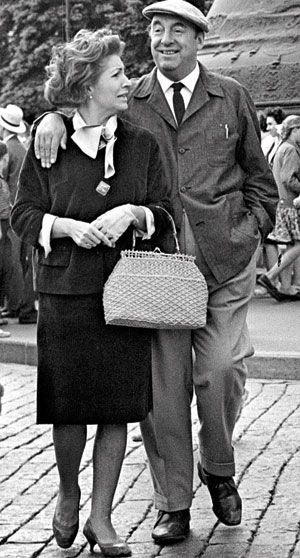

Presencia de Neruda en Capri
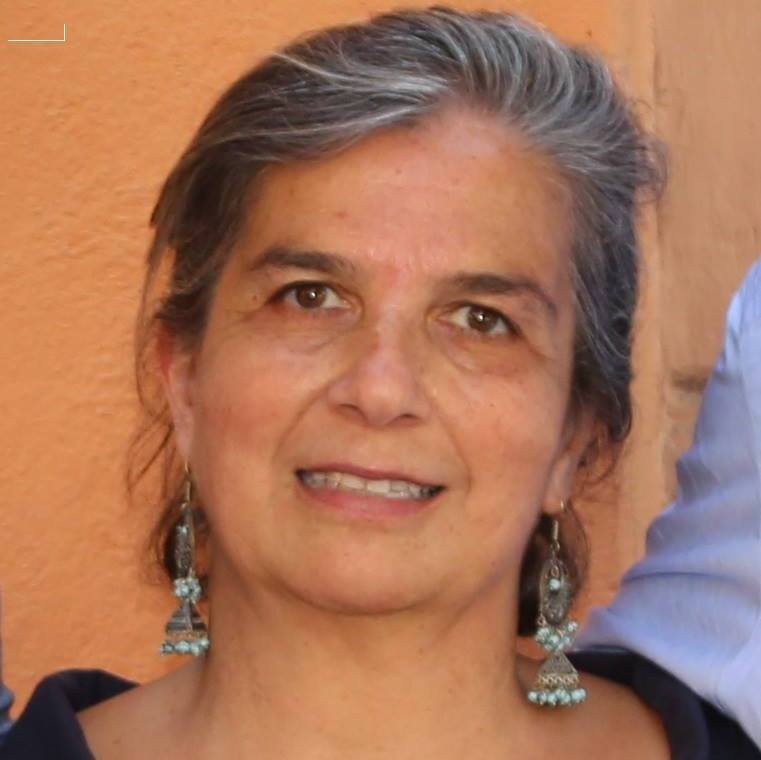
Since 1990, she has been a librarian at the Ignazio Cerio Capri Centre. Carmelina graduated in Modern Foreign Languages and Literature from the Oriental University Institute of Naples. She has researched the subject of English writers and travellers on Capri, also publishing numerous articles on the subject. For the Capri Centre she has been the Curator of the exhibitions “History of an Island and a Library”, “The Pagano Hostel: a family, their house, their guests”, “Three Centuries of Travellers in Capri”, and “Capri and the World in Drawings by Laetitia Cerio “.
Capri, reina de roca
It was a dark winter evening when Pablo Neruda and Matilde Urrutia arrived at “Arturo’s Casetta” in Capri. Edwin Cerio, who had made the house available for them, welcomed them at the light of the fireplace. A few days before, on 8 January 1952, the member of the Italian parliament Mario Alicata had written a heartfelt letter to Cerio, asking him to host the poet: “The great poet Pablo Neruda is in Naples and wishes to spend three months in Capri in order to finish his book on Italy (…) He would prefer living in a house, even a very tiny one, and not in a hotel or guesthouse (…) Perhaps I hope not to dare too much, could you see if you have one or two rooms available, somewhere?”
Edwin replied directly to Neruda, with a simple invitation telegram: “Come, I’m waiting for you in Capri. There is a villa, “Arturo’s Casetta”, ready to host you. There you will be undisturbed and you will have the possibility to finish your book and to rest”.
The six months they spent in La isla clandestina, as Neruda calls Capri, are documented by the epistolary between Edwin and Pablo, now preserved in Capri at the library of the “Ignazio Cerio” Centre. Such correspondence consists of 14 documentary units, mainly letters from Neruda, but also letters from Mario Alicata, as well as the minutes of some letters from Edwin, and an article celebrating the poet’s arrival on the island: “looking forward to your landing in a place where no curtain- of whatever metal- could be seen, and that has its borders only in the horizons of poetry and beauty” . Also there was an extraordinary invitation card “a beber una copa …” in tissue paper with Edwin’s face stylized on it, that was delivered on 25 March1952 to the owners of “Arturo’s Casetta”, invitation card that they luckily preserved. Most of the letters are written on rice paper bought in China and adorned with elegant designs of dragonflies, flowers and an ideogram: “it is my signature, in Chinese it means ‘three ears'”.
Edwin and Claretta Cerio were living across the road from Pablo and Matilde; the former lived in Villa Lo Studio, located right in front of “Arturo’s Casetta”, both were on via Tragara. They wrote to each other and the maid of both, Amelia, acted as “post woman”. They continued to write to each other also when Neruda and Urrutia moved to Via Li Campi, in a small house closer to the historic centre but certainly without the breathtaking view they had enjoyed in Marina Piccola. Apart from dealing with day to day issues and sometimes requesting advice, those letters clearly show the sense of hospitality, the commonality of interests, the curiosity for Edwin’s shell collections, the serenity that pervaded the couple and the inspiration that Neruda finds in the island’s natural beauties.
The letters between the two also reveal an incident that risked to undermine the relationship of esteem established between the guest and his landlord. Cerio, in making his home available, had established the condition that the poet – during his island stay – left apart his role as a communist militant. However, when he received a phone call from a Chilean who, arriving in Naples, asked him to speak with Neruda, he became worried and wrote to the poet: “I was very happy to make “Arturo’s Casetta”, available for you… it is in the tradition of Capri, of my family and of my small cultural centre to honour people of genius and intellectuals without asking them for any passports other than their work (…) as far as I am concerned, I have the shortcoming of disliking all sorts of politics (…) therefore, as I do not wish to sail under a false flag, I do beg you and your friends not to ascribe any political intention or manifestation to the hospitality I offered you”. The poet apologized for the inconvenience and assured that no political activity had taken place “as for your flag, I already knew it, a flag that rises with the colours and scents of your island” and promised him that there would be no more problems. And so it was.
On the island there was no reason for secret encounters with Matilda, as Delia del Carril was on the other side of the planet: they felt finally free to love each other, to do long walks to Anacapri climbing up the Phoenician Scale and to organize parties with their friends from of Rome and Naples. Pablo also devised a peculiar ceremony so that the love that bound them would be blessed by Capri’s moonlight.
Cerio – among other things – was fond of the island’s nature and Neruda was for him an interested interlocutor. For this he wanted to present the poet with a booklet of his, dealing with the blue lizard from Faraglioni, that had been printed on “Amalfi paper” and was at the time out of print. The present was extremely welcomed by Neruda..
When thanking his friend, Neruda made him apart of a project he has in mind: the publication of a book of poems dedicated to Matilda, Los Versos del Capitan. Quiet and peace on the island were ideal in order to allow him to finish his work. This collection will be published anonymously later on, by Paolo Ricci in July 52, when the poet had already left for Chile. It was published only in 44 copies out of commerce, each with the name of a subscriber. Apart from Cerio, there were Quasimodo, Guttuso, Giorgio Napolitano, Vasco Pratolini Palmiro Togliatti, Luchino Visconti, Giulio Einaudi, Renato Caccioppoli. To go today through that list (included before colophon at the end of the volume), it is like to reading a chapter of the history of this country.
The last letter to Edwin and Claretta, the one written when the poet was already sailing back to Chile on the motor ship Giulio Cesare, after Scelba had not renewed his residence permit, expresses the gratitude of Pablo and Matilde and their affectionate greetings to their friends in Capri. Friends that were not going to be forgotten after the return in Chile and were going to be the recipients of kind presents even thereafter.
Bibliography:
[Pablo Neruda], Los Versos del Capitan, Napoli, Arte Tipografica, 1952
Pablo Neruda, Confesso che ho vissuto, Milano, SugarCo, 1974
Teresa Cirillo Sirri, Neruda a Capri, sogno di un’isola, Capri, Edizioni La Conchiglia, 2001
Teresa Cirillo Sirri (a cura di), Matilde Urrutia: La mia vita con Pablo Neruda, Firenze, Passigli, 2002
Pablo Neruda, L’uva e il vento: poesie italiane, a cura di Teresa Cirillo Sirri, Bagno a Ripoli, Passigli, 2004.
Bibliografía:
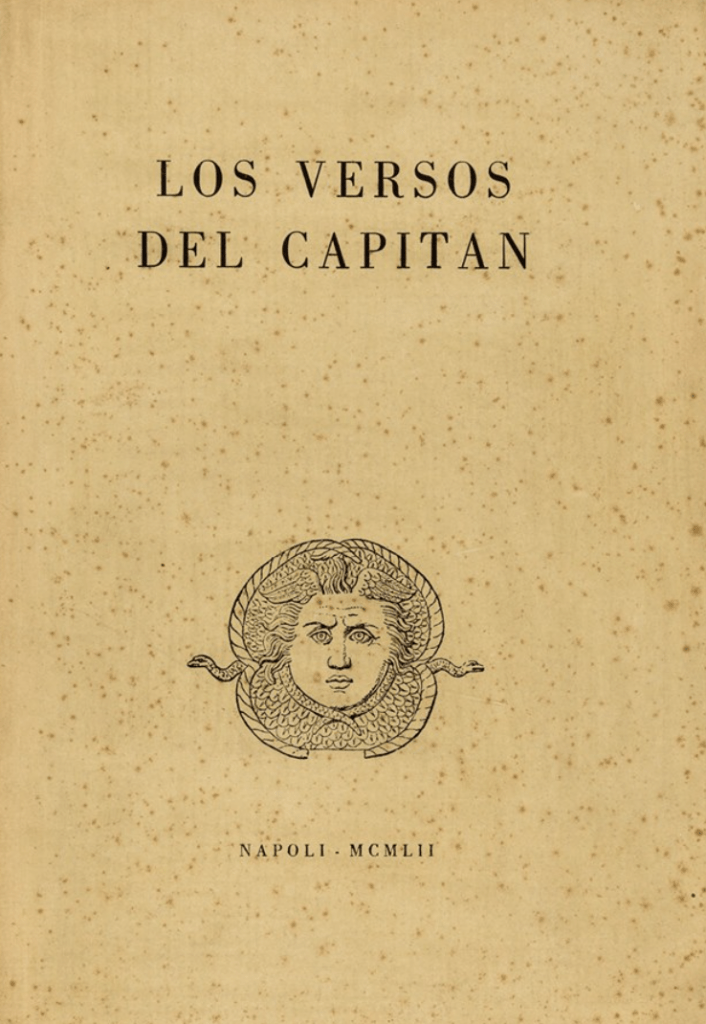
Cover of Los Versos del Capitán, Napoli, 1952.
| 1 | Matilde Urrutia | 23 | Paolo Ricci |
| 2 | Neruda Urrutia | 24 | Antonello Trombadori |
| 3 | Pablo Neruda | 25 | Giuseppe De Santis |
| 4 | Biblioteca Caprense | 26 | Ivette Joie |
| 5 | Claretta Cerio | 27 | Vittorio Vidali |
| 6 | Ilya Ehremburg | 28 | Luigi Cosenza |
| 7 | Elsa Morante | 29 | Carlo Bernari |
| 8 | Vasco Pratolini | 30 | Pietro Ingrao |
| 9 | Giulio Einaudi | 31 | Armando Pizzinato |
| 10 | Jorge Amado | 32 | Mario Montagnana |
| 11 | Mario Alicata | 33 | Gaetano Macchiaroli |
| 12 | Editore Gaspare Casella | 34 | Ernesto Treccani |
| 13 | Nazim Hikmet | 35 | Francesco De Martino |
| 14 | Palmiro Togliatti | 36 | Alessandro Vescia |
| 15 | Luchino Visconti | 37 | Angelo Rossi |
| 16 | Renato Caccioppoli | 38 | Giuseppe Zigaina |
| 17 | Stephen Hermlin | 39 | Gianzio Sacripante |
| 18 | Elvira Pajetta Berrini | 40 | Massimo Caprara |
| 19 | Salvatore Quasimodo | 41 | Clemente Maglietta |
| 20 | Bruno Molajoli | 42 | Lino Mezzacane |
| 21 | Carlo Levi | 43 | Gerardo Chiaromonte |
| 22 | Renato Guttuso | 44 | Giorgio Napolitano |
Los Versos del Capitán, digitized
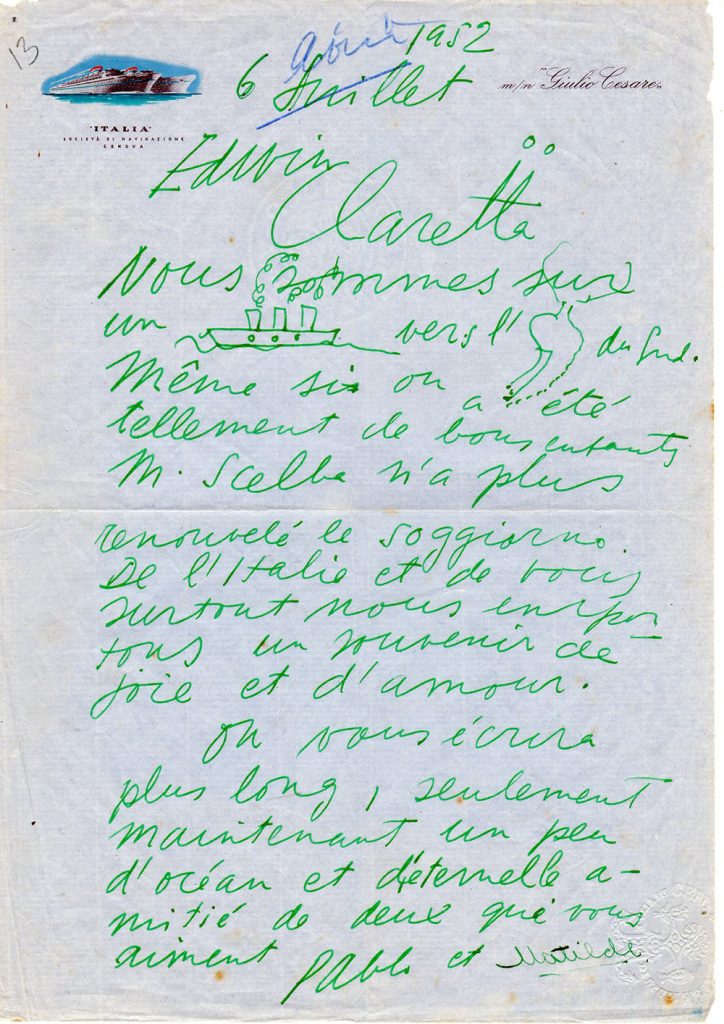
Letter from Pablo Neruda to Edwin and Claretta Cerio (July 6, 1962).


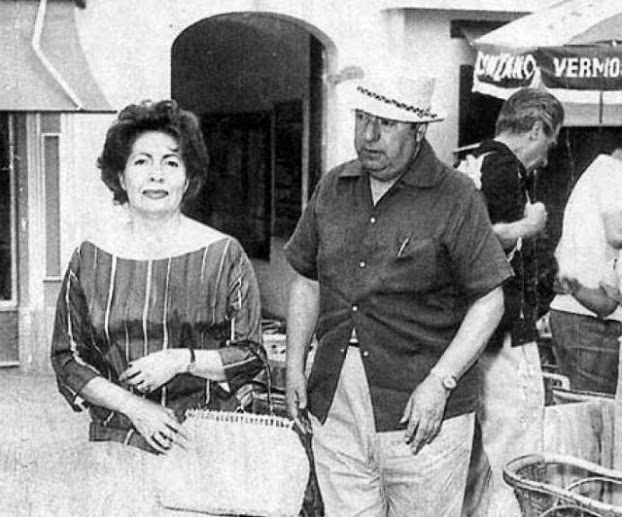

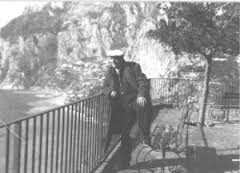

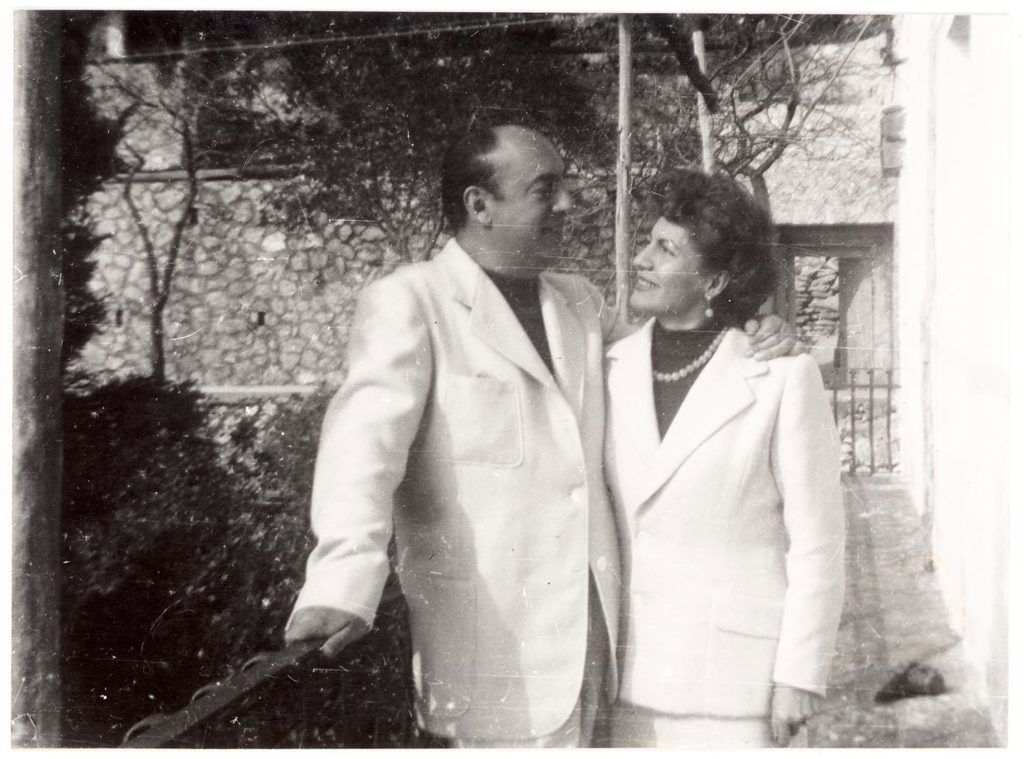

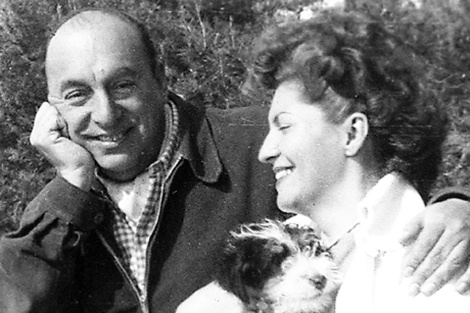

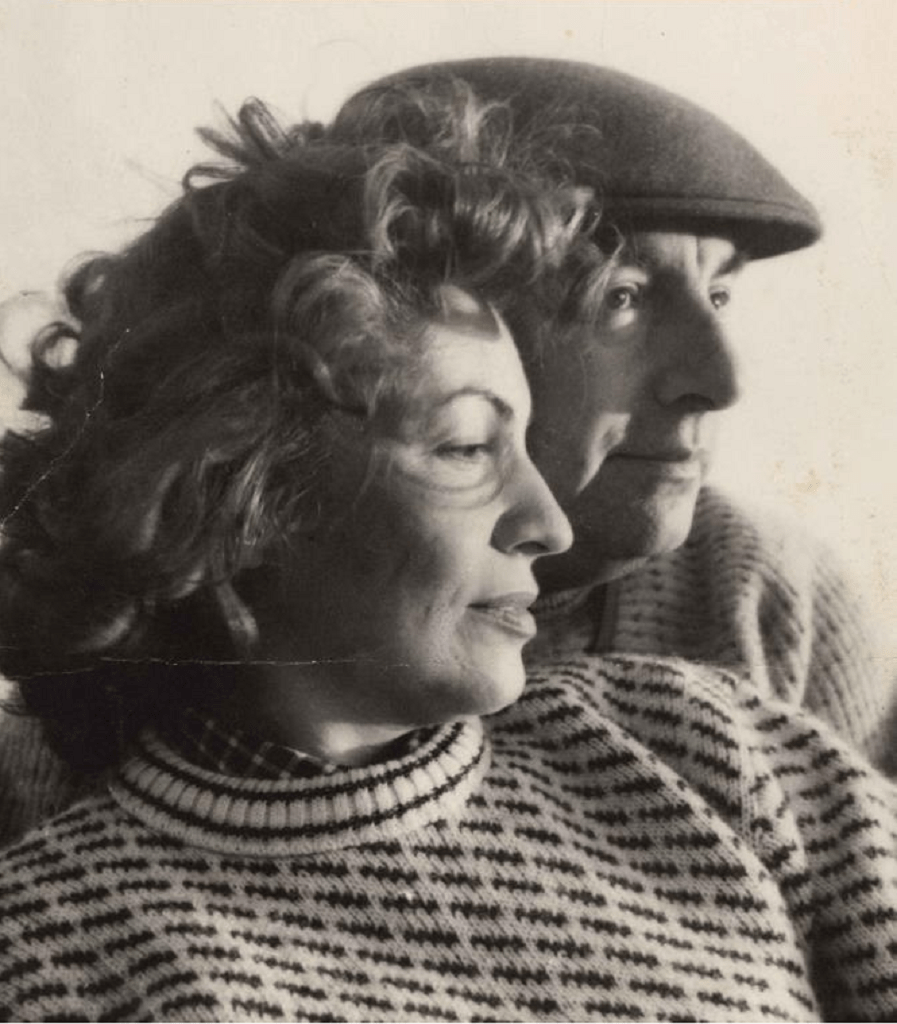








Economist, university professor, Ambassador of Chile in Italy (2000-2004), writer.
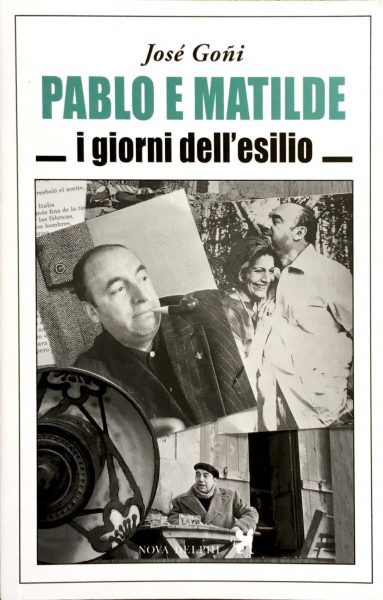
Pablo and Matilde, the days of exile. Nova Delphi Libri, Rome, Italy, 2018, 310 pages.
Pablo Neruda en Italy
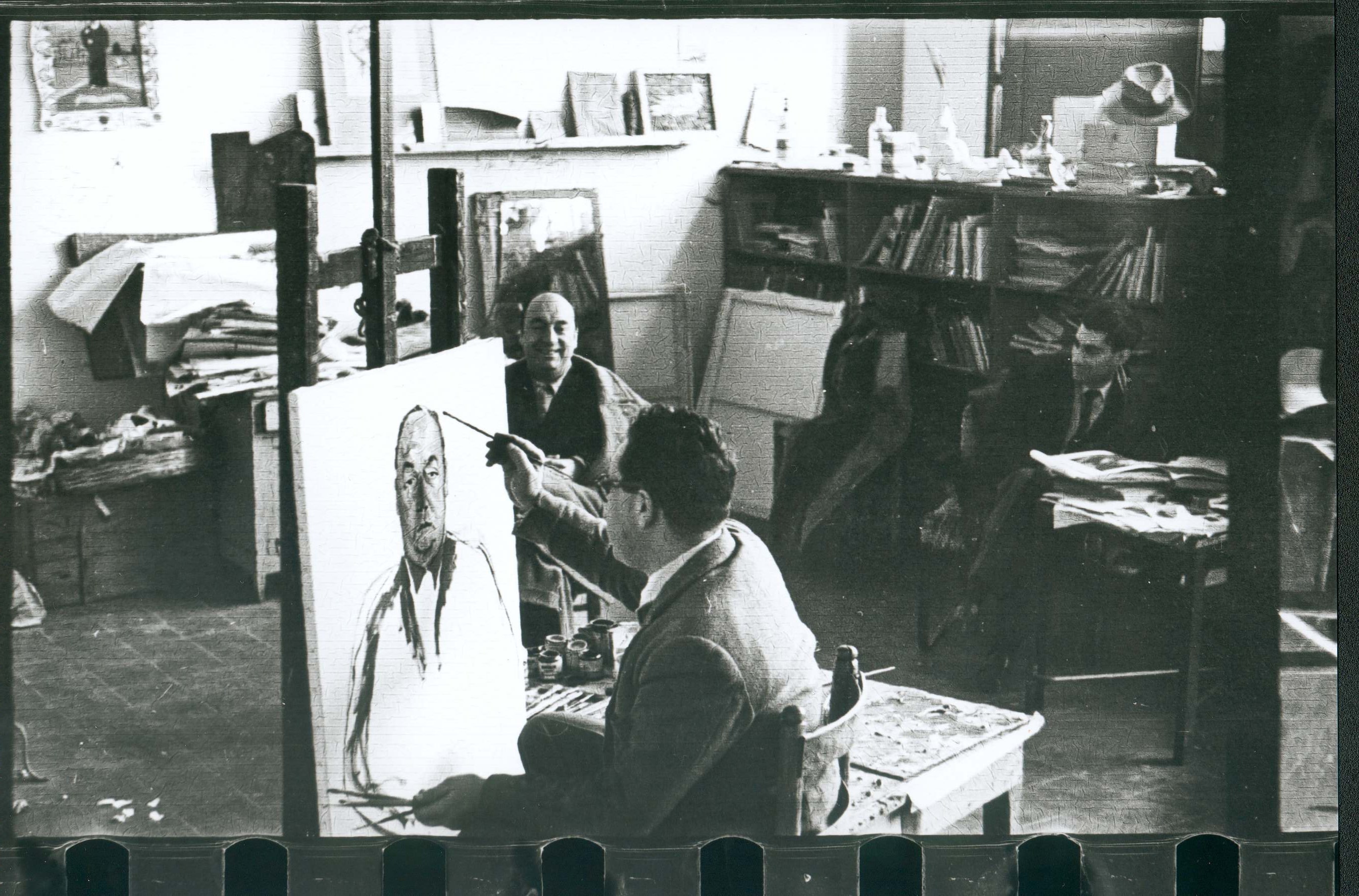

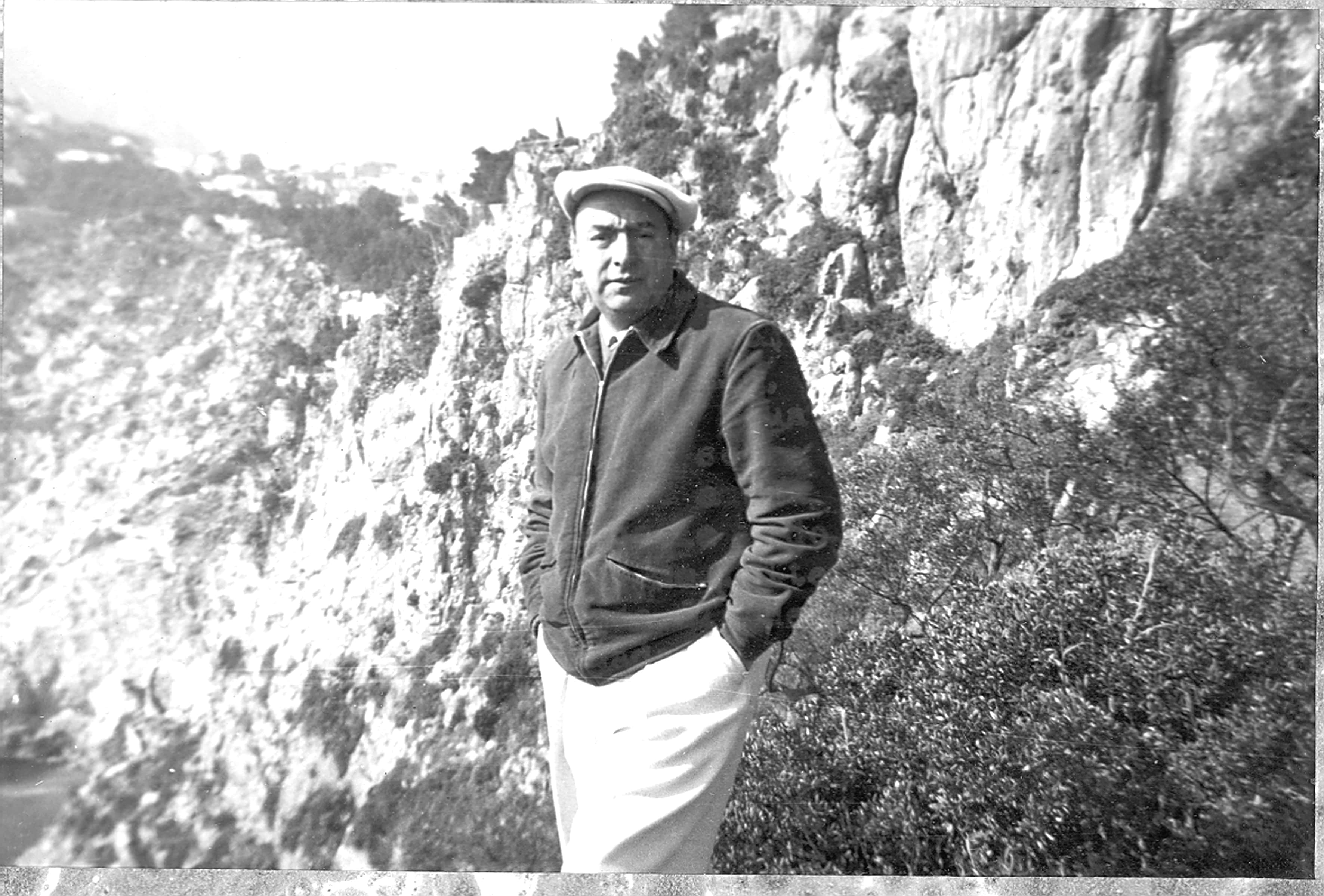





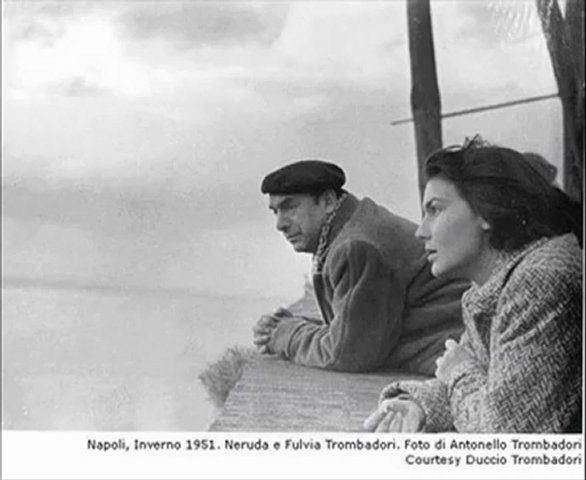

El pintor Renato Guttuso retrata en su taller a Pablo Neruda. Foto: Antonello Trombadori, periodista, crítico de arte y político, gran amigo del poeta, casado con Fulvia Trozzi (hija de Mario Trozzi, abogado y Diputado).
El poeta en Capri. Foto: Antonello Trombadori.
En el Hotel Belvedere, de Capri. Delia del Carril, Fulvia Trombadori y el poeta, antes de que llegara Matilde (1950-1951).
Nápoles, invierno de 1951. El poeta junto a Fulvia Trombadori y Paolo Ricci, gran amigo napolitano, pintor y crítico de arte que, en julio de 1952, editó Los Versos del Capitán, libro que fue publicado en solamente 44 ejemplares para los amigos, previa suscripción. El es quien consiguió la "Casetta d'Arturo", la casa en la cual el poeta permaneció en gran parte de su estadía en Capri, propiedad de Claretta y Edwin Cerio.
Con Fulvia Trombadori en Nápoles, invierno de 1951.





Pablo Neruda in Italia










El pintor Renato Guttuso retrata en su taller a Pablo Neruda. Foto: Antonello Trombadori, periodista, crítico de arte y político, gran amigo del poeta, casado con Fulvia Trozzi (hija de Mario Trozzi, abogado y Diputado).
El poeta en Capri. Foto: Antonello Trombadori.
En el Hotel Belvedere, de Capri. Delia del Carril, Fulvia Trombadori y el poeta, antes de que llegara Matilde (1950-1951).
Nápoles, invierno de 1951. El poeta junto a Fulvia Trombadori y Paolo Ricci, gran amigo napolitano, pintor y crítico de arte que, en julio de 1952, editó Los Versos del Capitán, libro que fue publicado en solamente 44 ejemplares para los amigos, previa suscripción. El es quien consiguió la "Casetta d'Arturo", la casa en la cual el poeta permaneció en gran parte de su estadía en Capri, propiedad de Claretta y Edwin Cerio.
Con Fulvia Trombadori en Nápoles, invierno de 1951.





Un largo viaje con el Capitán. Capri, 2004.
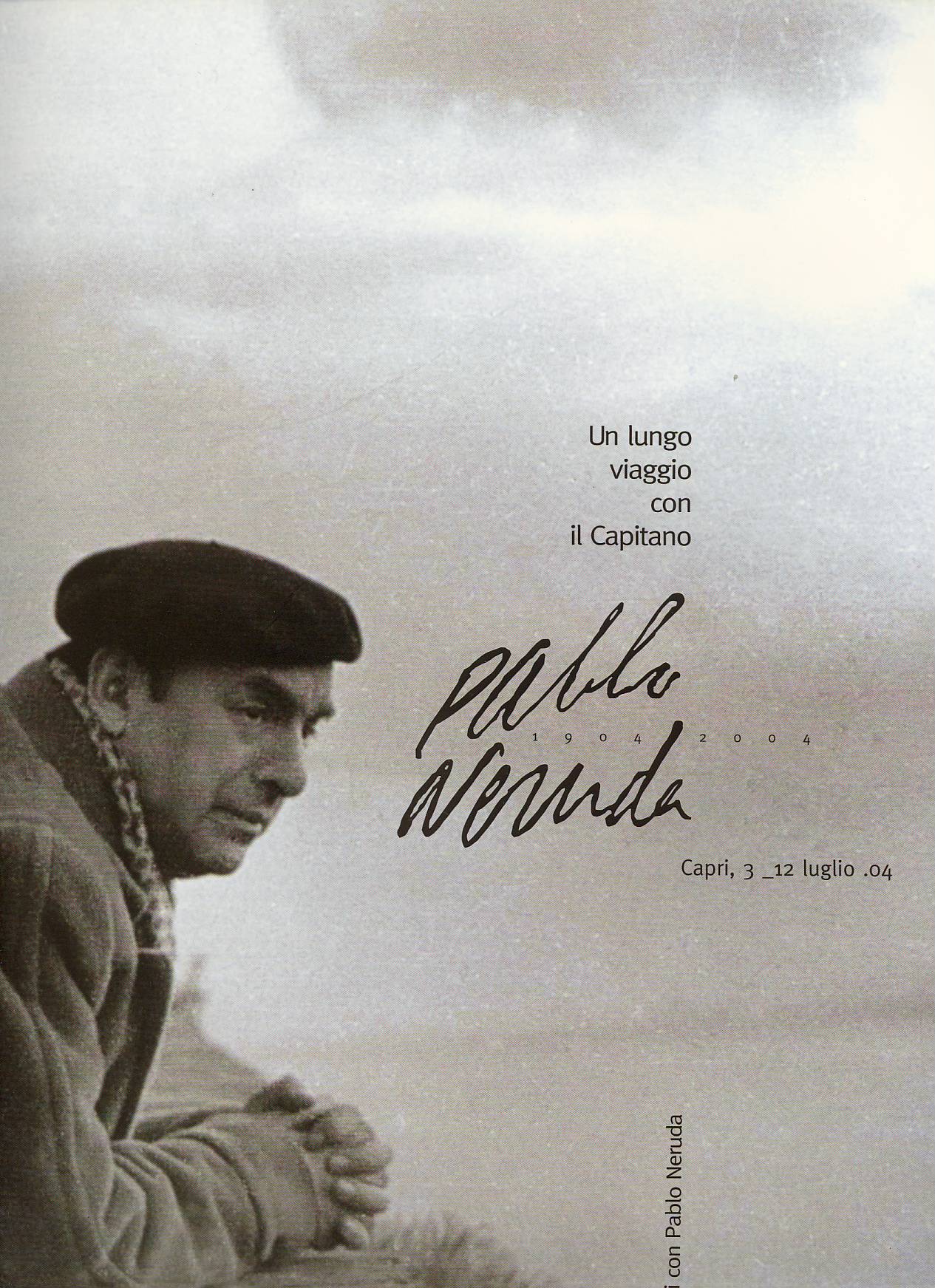

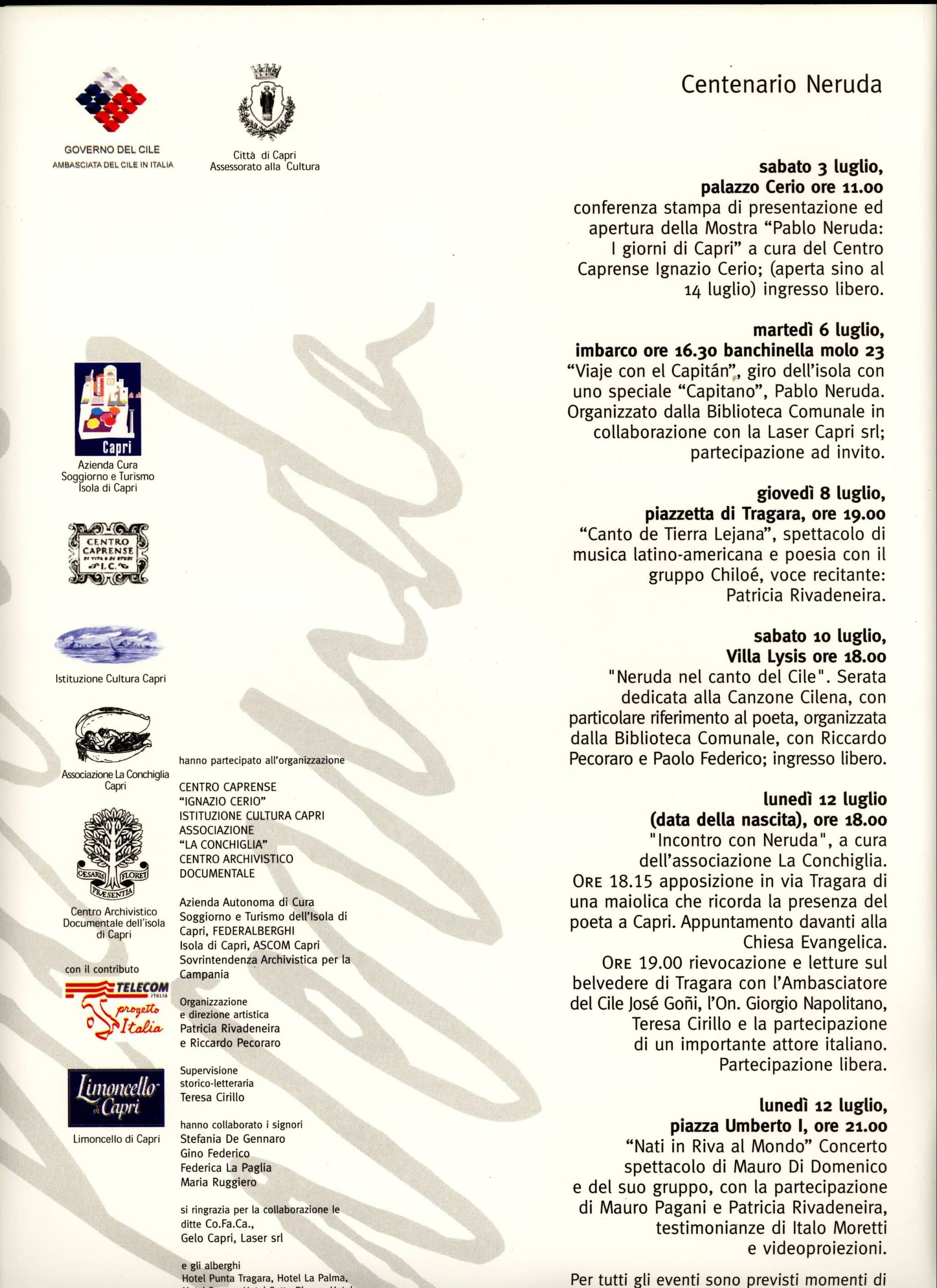



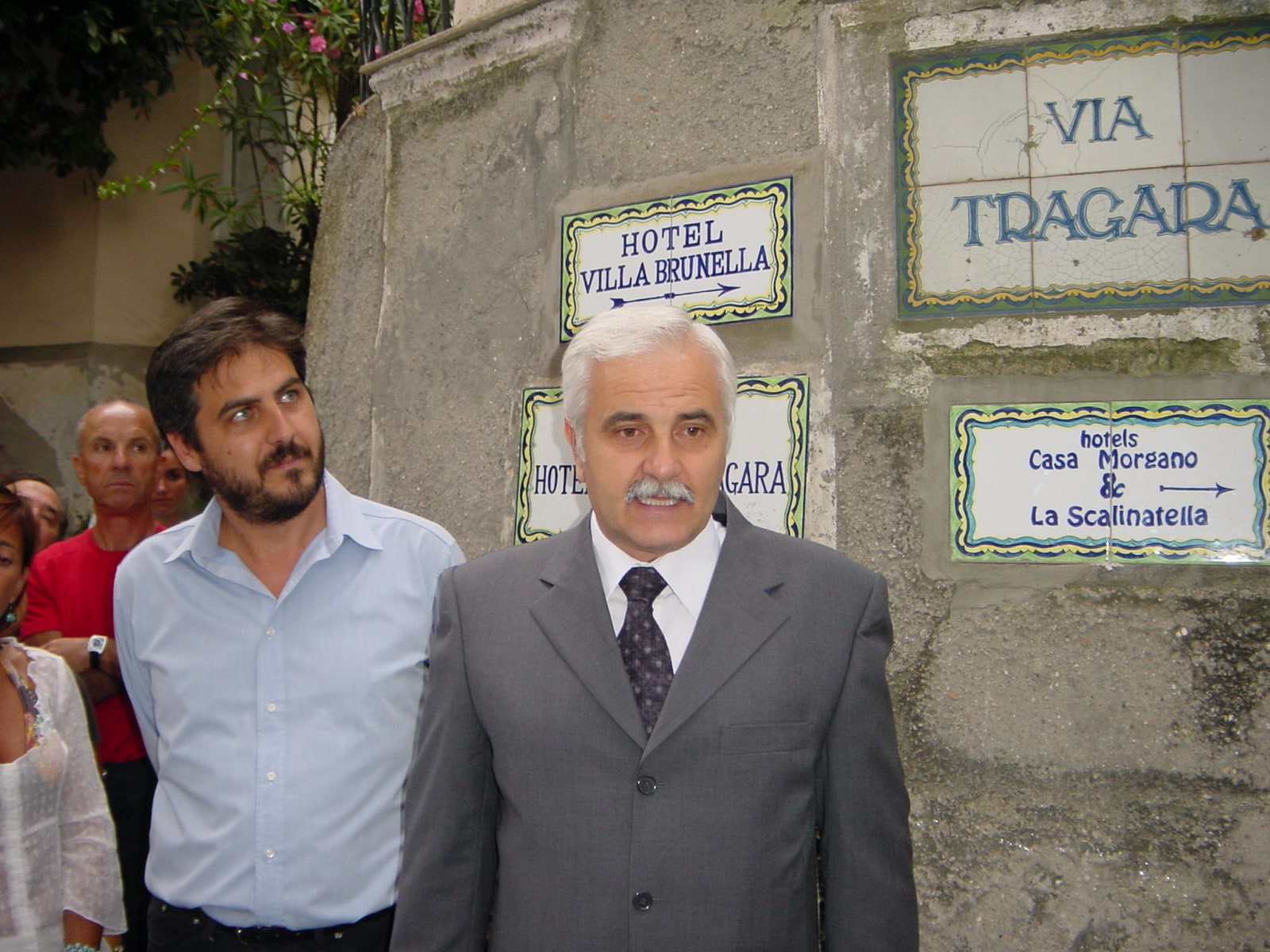

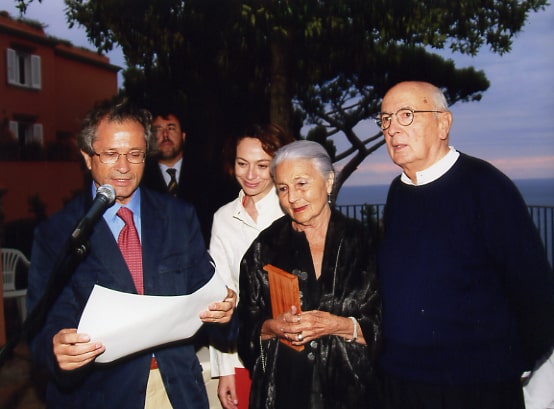

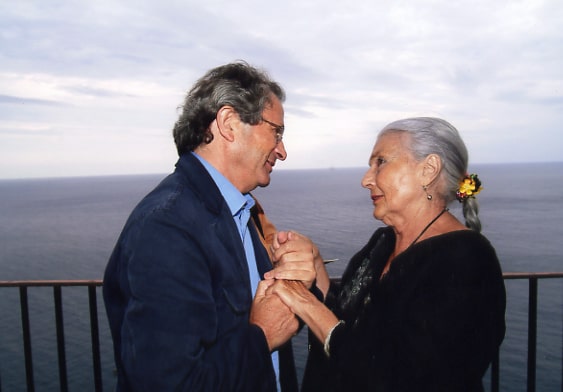

Poster del evento cultural "Un largo viaje con el capitán", realizado en Capri, del 6 al 12 de julio de 2004.
Programa de las actividades culturales realizadas en Capri, durante la semana dedicada a Pablo Neruda en 2004, con motivo del centenario de su nacimiento.
Bandera chilena en Via Tragara, donde vivió Pablo Neruda a comienzos de la década del 50.
El Alcalde de Capri, se dirige a los invitados a la ceremonia. Junto a él, se encuentra el Asesor de Cultura de la Municipalidad de Capri.
El señor Embajador de Chile en Italia José Goñi, la Agregada Cultural de Chile en Italia Patricia Rivadeneira, Fulvia Trombadori y Giorgio Napolitano, actualmente Senador Vitalicio, fue Presidente de la Cámara de Diputados, Ministro del Interior y Presidente de la República de Italia (2006-2015). También fue amigo de Neruda y uno de los 44 propietarios de Los Versos del Capitán.
El Embajador de Chile en Italia José Goñi y Fulvia Trombadori, durante el evento cultural dedicado a Neruda.






Visit Enrico Tallone and his mother, Bianca Bianconi.
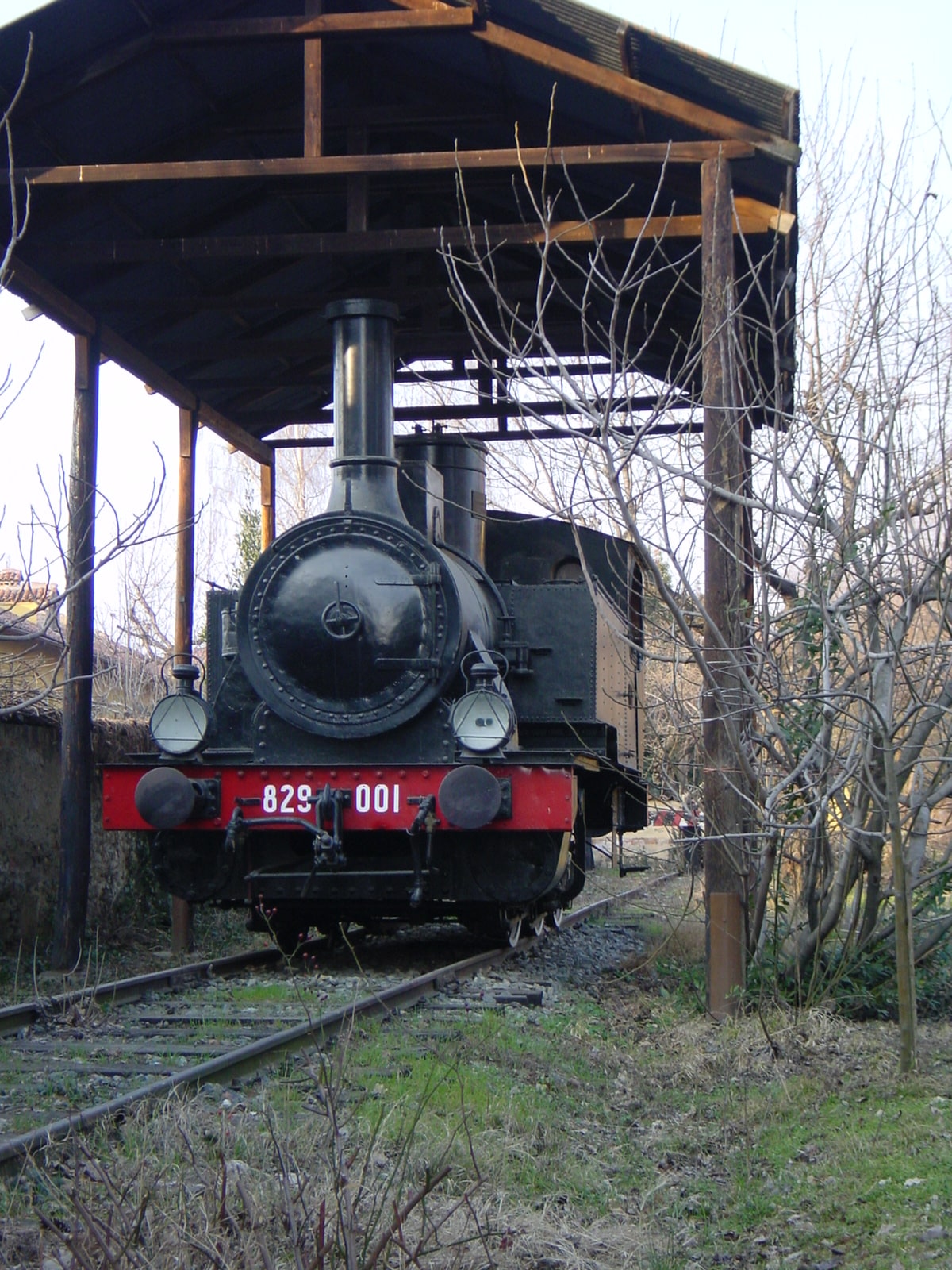

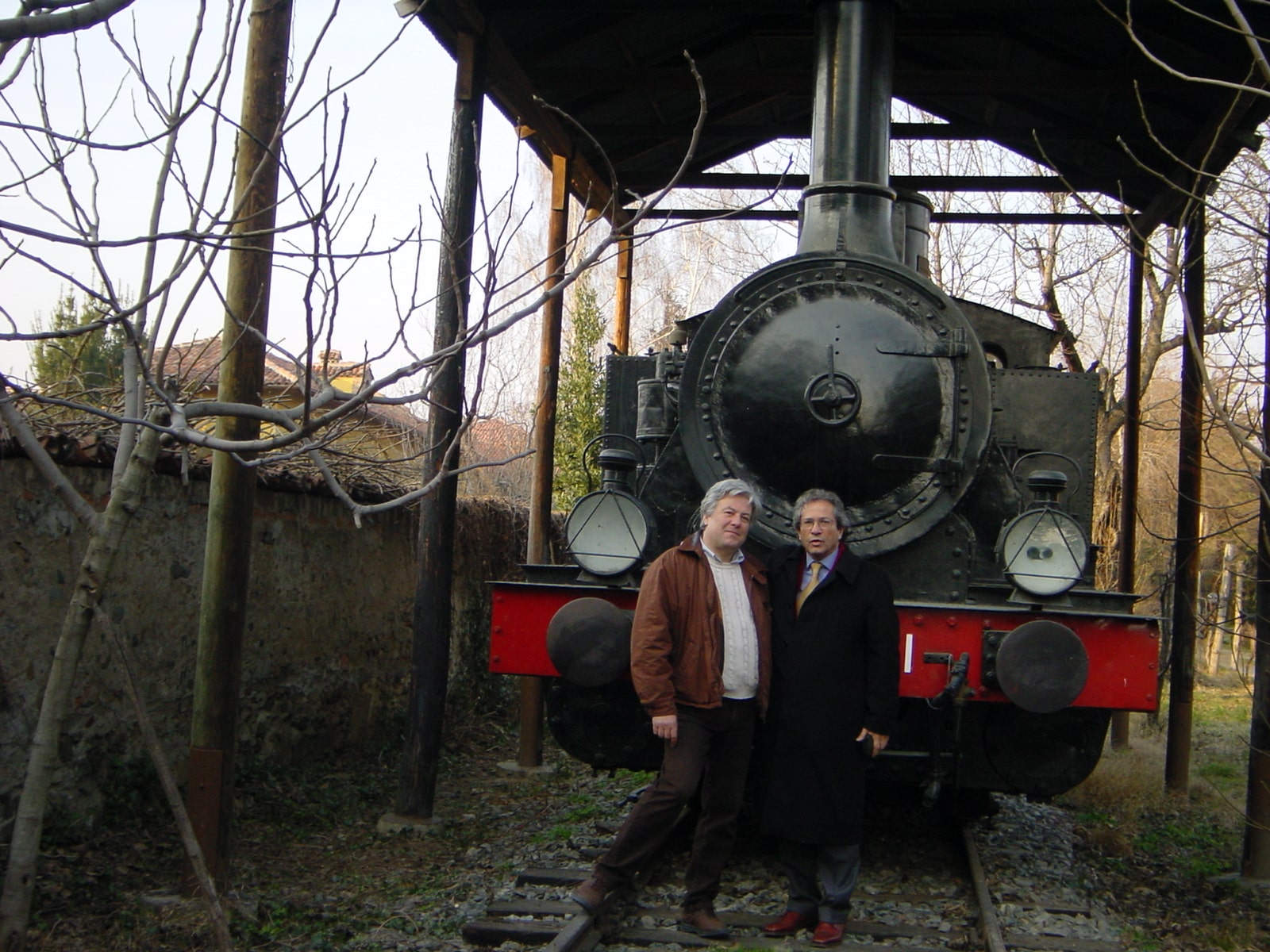

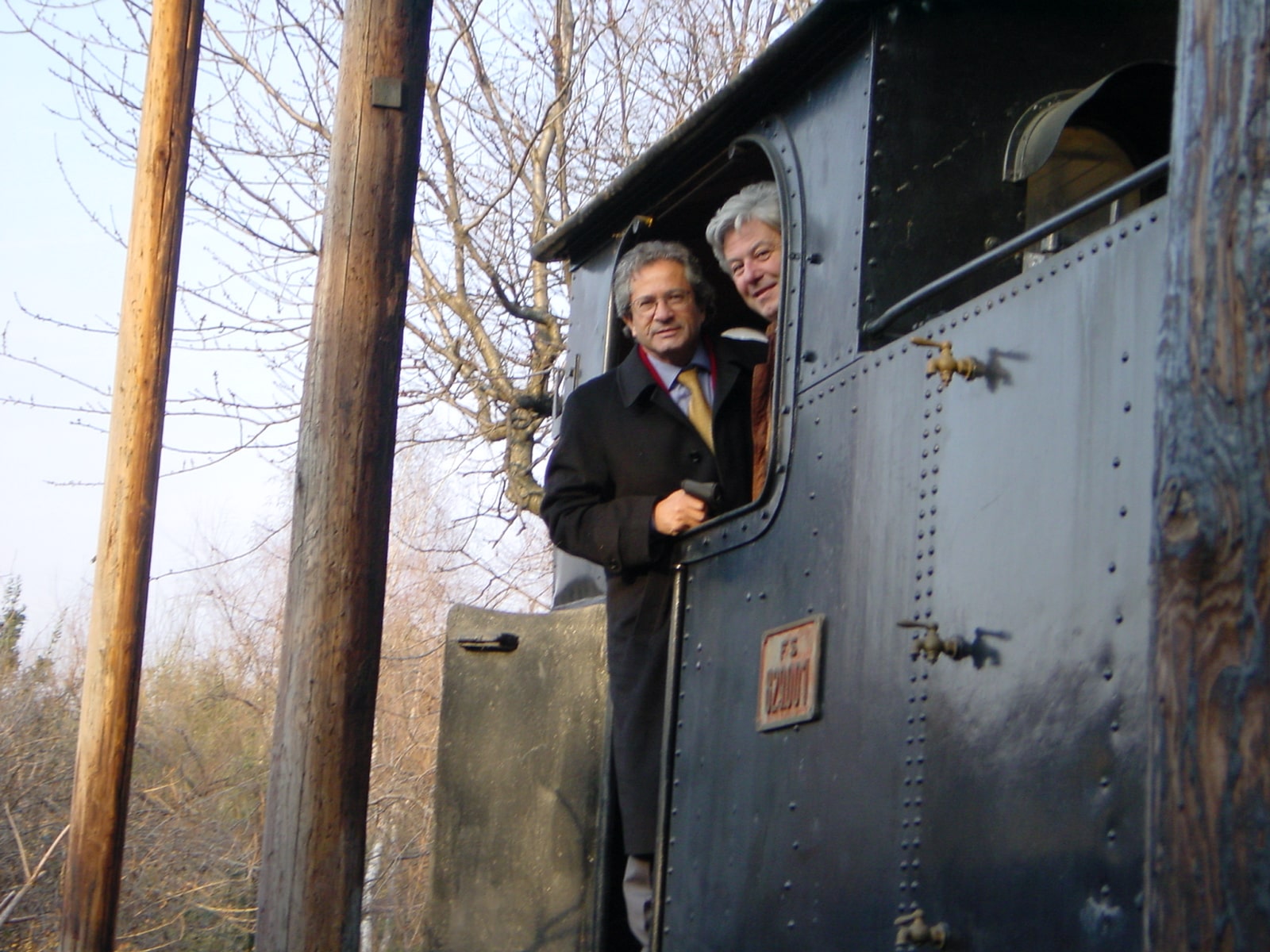

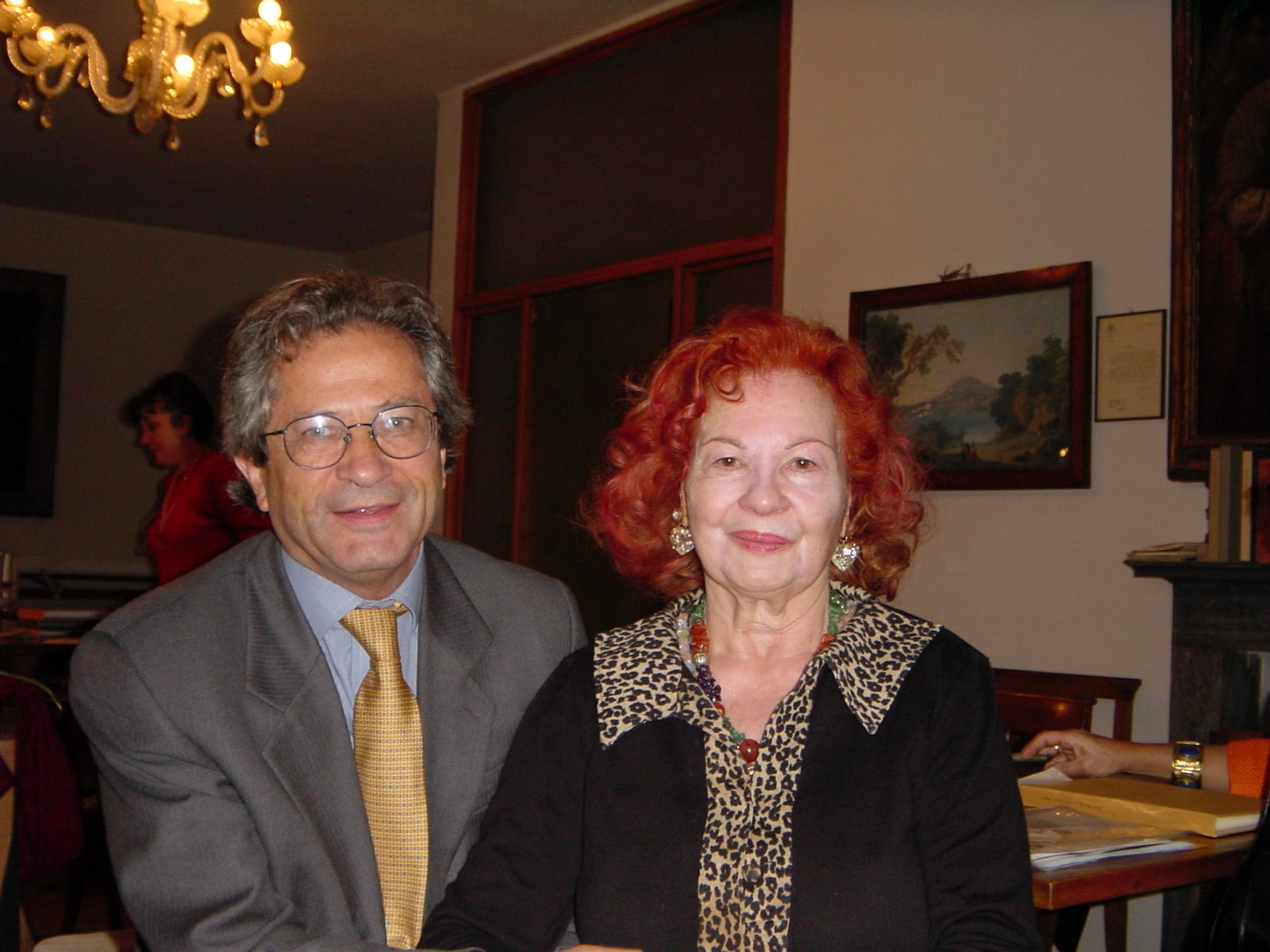

Locomotora en Alpignano.
Enrico Tallone y José Goñi, Embajador de Chile en Italia en aquella época (2000-2004).
El Embajador de Chile en Italia (2000-2004) José Goñi, con Enrico Tallone.
El Embajador de Chile en Italia (2000-2004) José Goñi, con Bianca Tallone.




Libro Pablo Neruda. Passi in Italia.
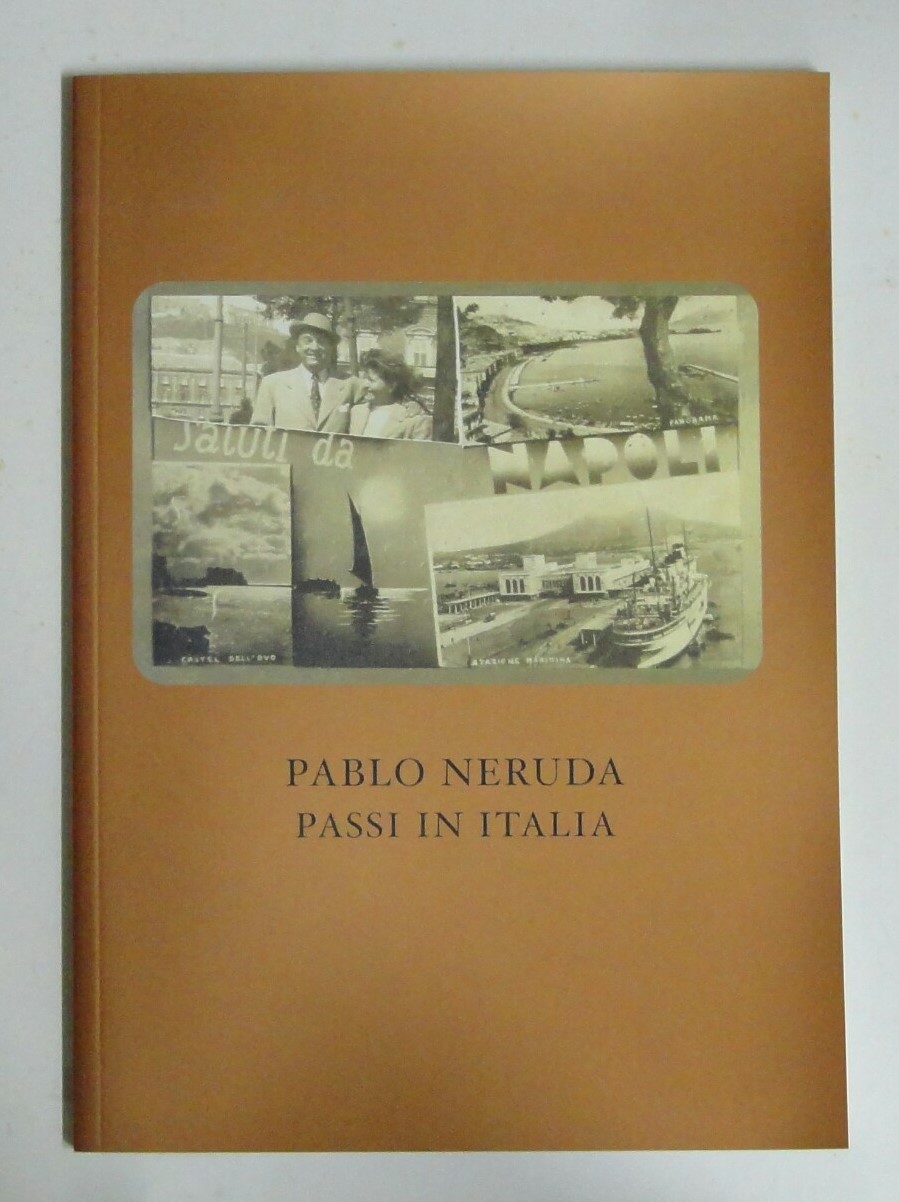

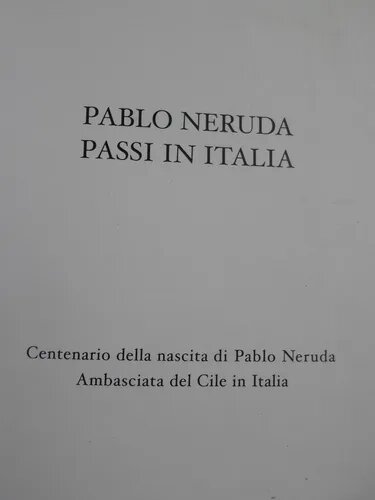

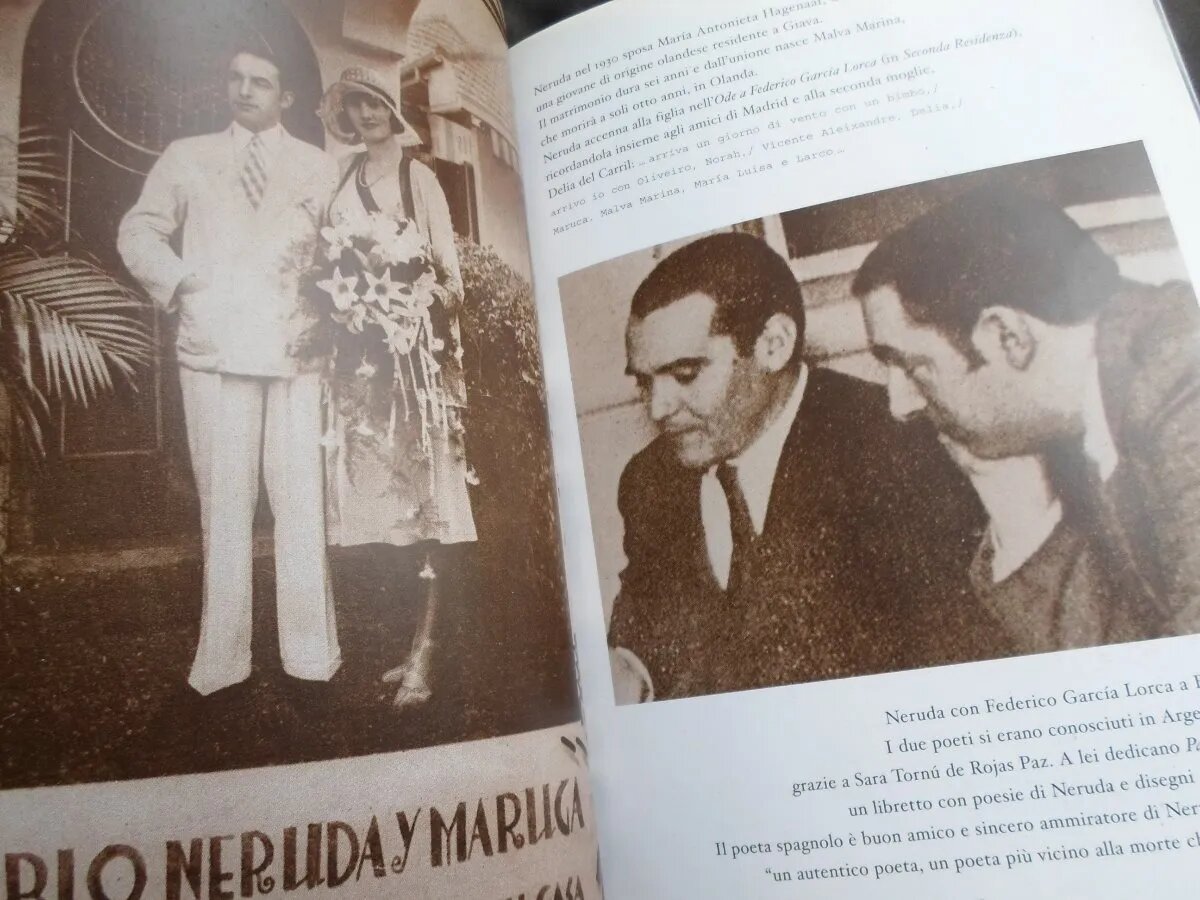

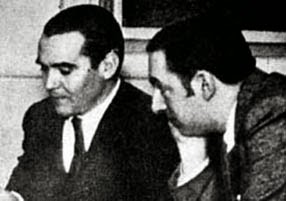

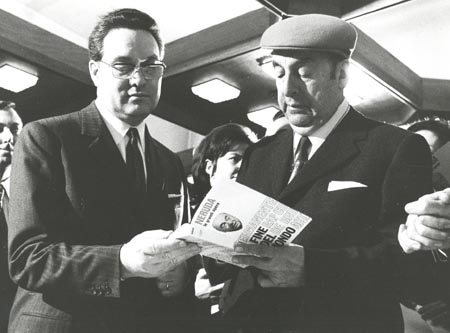

Portada del libro.
Libro publicado en Roma el año 2004
Interior del libro.
El poeta español Federico García Lorca y Pablo Neruda.
Giuseppe Bellini y Pablo Neruda en Milán.






Licenciado en Literatura y Doctor en Educación. Socio de la Sociedad de Bibliófilos Chilenos. Investigador de Booklife Asesorías Editoriales.
Le Pagine dell’Isola
Ignazio Cerio Capri Centre
These pages analyse some writings of Norman Douglas, Oscar Wilde and Pablo Neruda where the unique island of Capri is present. Its authors are Menichelli and Barattolo. They were published in 2003 by Giannini Press of Naples.
The particular beauty of the island and its people, an astonishing combination of peasant and maritime culture, has for centuries attracted various personalities who have enjoyed a unique enclave, a perfect setting for Pablo Neruda who arrives at the Marina Grande in 1952.
Pablo and Matilde settle in Arturo`s House in Vía Tragara, which is kindly loaned for a few months by Edwin Cerio, a protector and scholar of the island’s nature and a point of reference for the writers, artists and scientists who visited it.
The dark house becomes a luminous stage where Matilde is the bearer of light and happiness and, most importantly, becomes the clandestine refuge where her anonymous book The Captain’s Verses will end.
Remember when
in winter
we arrived to the island?
The sea raised toward us
A glass of cold (…)
You inhabited the house
What awaited you dark
And you lit the lamps then …
Menichelli and Barattolo’s text mainly analyses the idyllic figure of Capri in the Captain`s Verses, which sing with lyrical urgency a passionate and sensual love that represents a decisive stage in the artistic process and in the emotional life of the Poet. This sweet and passionate period lived intensely with the woman he loved in the island retreat is transformed, through dazzling poetry, into a happy and renewed expression of beauty and love.
Books
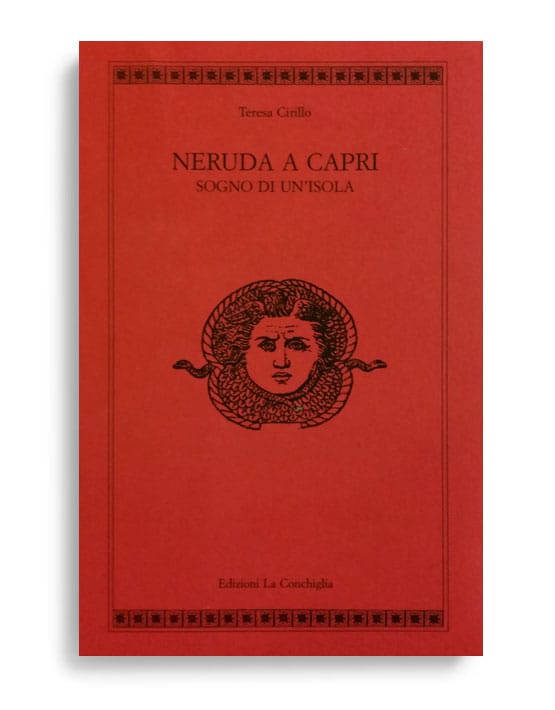
Neruda a Capri. Sogno di una isola.
I created you, I invented you in Italy …
I slept the whole night with you
by the sea, on the island.
Wild and sweet you were between pleasure and sleep,
between fire and water.
Neruda in Capri is a work by Teresa Cirillo Serri, professor of Hispanic American Literature at the Oriental University of Naples.
The book is divided into three chapters: Dreams of an Island, Lovers of Capri and Letters from Capri. In addition, it contains a selection of Neruda`s poems in Spanish and Italian inspired by the heavenly setting and by his lover, Matilde.
Neruda arrived in Capri at the beginning of 1952 because he was looking for a refuge to hide from political persecution and, also, to live his intense love with Matilde. His Italian friends help him so that he is not deported and so that he could live his romance with peace of mind.
The backdrop: the island of stone, moss, ivies, and vineyards in the rock, becomes one of the characters in this story that, told in an entertaining and documented way, recounts a six-month hiatus of joy from the couple in Capri, where for some time they lived in Arturo`s House, a small white house located in a beautiful natural setting, owned by the eminent intellectual and writer from Capri, Edwin Cerio.
The stay in Capri represents the first step towards Neruda’s indissoluble and definitive union with his clandestine love, a fact that is immortalized in the anonymous book The Captain’s Verses, co-financed by Italian personalities and intellectuals, and published in Naples in July 1952.
The reading of this story flows in a dynamic way, nuanced with aspects of the historical context, Neruda’s difficulties to obtain a temporary residence permit, the details of the idyllic love, the days of poetic creation, the meetings with friends and the walks through the hills and corners of the dream island.
Island, from your walls / I detached the little night flower / and I keep it on my chest. / And from the sea turning around you / I made a ring of water / that was left there in the waves, / enclosing the proud towers / of flowered stone, the cracked peaks / that my love held / and will keep with implacable hands / the footprint of my kisses. (The grapes and the wind))
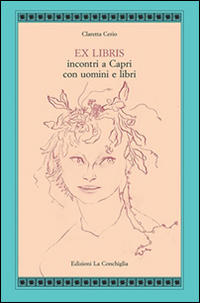
Ex Libris. Encounters in Capri with men and books.
Claretta Cerio
How many things,
limes, thresholds, atlases, cups, nails,
they serve us like unspoken slaves,
blind and strangely stealthy!
They will last beyond our forgetfulness.
They will never know that we are gone.
Ex Libris describes notable characters who passed through the island of Capri. In the chapter dedicated to Pablo Neruda, its author, the Italian-German writer Claretta Wiedermann Cerio, characterizes him as a curious child surrounded by surprising and strange objects that made up his personal universe. This interest seemed to externalize the complex facets of his inner being: curiosity, fantasy, sensitivity, humour, passion.
In the house of Via Tragara he feels at ease, he acquires a sense of security and tranquillity, something that he had lacked until that moment, during his wandering existence as a political exile. At the same time a new life begins with Matilde.
In their Italian refuge, the lovers expressed an overflowing joy that it was necessary to share with those who could understand their language of madness and their complete departure from common sense. Edwin and Claretta got it. They had recently married and were expecting a daughter. At that moment they were infinitely happy and they also wanted to share their happiness, therefore, when all four where together there was a magical element that materialized in a brief and consummate happiness.
Some hint of that feeling can be seen in one of Neruda’s many messages to the couple that, Claretta says, can be read like poetry.
Dear Claretta and Edwin,
Unique friends,
our happiness
greet your happiness.
Tenderly
Pablo and Matilde.
Claretta and Edwin undoubtedly became essential figures in Pablo and Matilde’s life during their stay in Capri. His two dear friends and the dream island are the protagonists of the poem ¨Farewell to the Snow¨ in Memorial de Isla Negra.
Claretta became a prolific German novelist. He passed away in August 2019, at the age of 92.
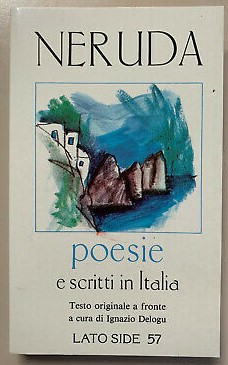
Ignazio Delogu: Poesie e scritti in Italia.
Roma, Lato Side Editori, 1981.
I entered Florence. It was
night. I trembled listening
almost asleep to what the sweet river
told me.
Neruda’s Italian experience is part of the second period of his life and work. In 1949, during the First World Peace Congress in Paris, he reunited with some of his Italian friends and created new ties with others. Among them there were the main intellectuals who contributed to the spread of his art in Italy: Quasimodo, who translated a poetic anthology for Einaudi; Renato Guttuso who illustrated that anthology; Dario Puccini, who was the first Italian translator and scholar of his work and Mario Socrate who collaborated in the translations. The latter published Reading of Canto General in the Turin magazine Società (1950), where he offered the Italian readers the first critical elements for the knowledge of the poet’s work, which is an important fact because, until that moment, he was unknown in Italy.
Neruda’s first visit to Italy was brief, between October and November 1950. On that occasion, he toured Rome with Delia del Carril. This memory was enduring and was reflected in the poem ¨The Fruits¨ in Grapes and the Wind. It was during his second stay in Rome (December 12, 1950 – January 1951) that he met Mario Alicata and Paolo Ricci. This time, he began a trip to some Italian cities. Florence inspired ¨The Sweet River¨ and ¨The Golden Arno¨. In Turin, he was a guest of the Einaudi publishing house. The journey continued to Venice, Milan, and Genoa. In addition, he visited Gabriela Mistral in Rapallo, who at that time was Consul General of Chile.
Neruda returned to Naples at the end of 1951. In those days, a controversial order of expulsion from the country was revoked due to political pressure, and he was allowed to remain in Italy. He settled on the island of Capri, where he wrote most of The Grapes and the Wind and completed and edited the Captain’s Verses. The latter’s edition was Neapolitan and financed entirely by his friends, most of whom were Italian. It is a key book, according to Delogu, without which the life and work of the Poet would be difficult to understand because this pause in Capri allowed extraordinary concentration and encouraged a positive conception of life, beyond poetry.
According to Delogu, 1951 was Neruda’s Italian year. After the publication of ¨Wake up the Woodcutter¨ in Rinascita’s newspaper supplement, the poem was reproduced, disseminated, and widely commented on. Finally, on December 9, marking the end of the Italian poetic cycle, the newspaper L’Unita published it in full on its central page.
Although the first few years of the 1950s were the most significant in Neruda’s incipient relationship with Italy, it is in the 1960s when that relationship was consolidated with the publication of two anthologies: Poetry by Giuseppe Bellini (Milan, Nuova Academia, 1960) and Poetry by Dario Puccini (Florence, Sansoni, 1962). In addition, the anthology translated by Quasimodo was reedited, and was widely disseminated and became a publishing success.
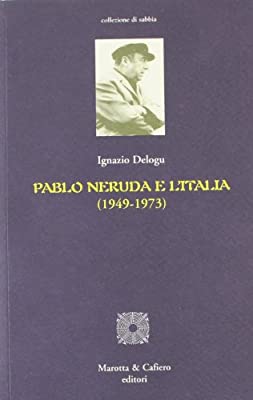
Ignazio Delogu: Pablo Neruda e l’Italia 1949-1973
Motta & Caffiero, Nápoles, 2007.
The richness of Neruda’s poetry is due, among other factors, to the contributions of the various cultures of the countries through which he passed or lived. Italy is undoubtedly at the forefront of them, and Ignazio Delogu, a poet and his friend, reviews in this book the key moments that have linked Neruda to Italy. The work is mainly based on two aspects: the documented testimony of Neruda’s presence in Italy and the critical analysis of his poetry.
Towards the end of October 1950, during his first visit to Italy, Neruda travelled to Rome, where, once again, he met his friend Libero Bigiaretti and came into contact with Moravia, Elsa Morante, Guttuso, Debenedetti and with communist politicians such as Emilio Sereni and Ambrogio Donini. He also met Italian artists and intellectuals of a progressive left line such as Antonello Trombadori, Antonio Scordia, Galvano Della Volpe, Sibila Aleramo, Mario de Micheli and Saltvatore Quasimodo.
In the book, Neruda is described as a strong and independent person, with a dynamic sensual relationship with life, eternally animated by a curiosity that was not only intellectual, but also material. Guttuso remembers him walking through the streets and markets to buy decks of cards, shells and similar objects. For his part, Trombadori remembers him searching for books in the antique shops around Piazza di Spagna and the Roman College.
The “Rabelesian Disposition” of the Poet, his taste for learning about the material culture of the people who welcomed him and his enthusiasm for typical trattoria and Italian cuisine are underlined in the book. He is also frank and generous, but at the same vain and a tireless attention seeker. Mario Socrate says: “He was always surrounded by his court. It was evident that he considered himself the greatest poet in the world”.
Neruda visits Naples at a time of intense cultural activity, where there is a frenzy of renewal and rebirth. Here the friendship between the poet and Dario Puccini is reinforced, and he would become the main Italian scholar who studied his poetry and is an exemplary translator of Canto General. Puccini remembers, ¨ I was Neruda’s love postman, because I put the letters in the mailbox for Matilde. I remember him with emotion and irony. I was his first translator and the first to speak about him in Italy”.
Florence, Venice, Turin, and Genoa are other stages of the Neruda’s presence in Italy, where the poet not only interacts with artists and intellectuals, but also with people from the town, labourers, or simple militants of left-wing parties. During his poetry recitals in factories or crowded rooms, he is always monitored by the police.
Now Neruda intends to spend time in Capri, he receives an expulsion order. This fact provokes the indignation of intellectuals and politicians, but the decision is reversed, and he is authorised to reside in Italy for a few months. From that moment on, Matilde Urrutia enters his life permanently, as is testified in The Captain’s Verses.
Magazine “Nerudiana”, of the Pablo Neruda Foundation. Santiago de Chile, N ° 13-14, March-December 2012. Director: Hernán Loyola.
Congresses, conferences, magazines, book references. Commemorative events to mark the centenary of the birth of the great Chilean poet Pablo Neruda (1904-2004), “From the Mediterranean to the Oceans”. Newsletter N ° 16 (April 2005), in the care of Clara Camplani and Patrizia Spinato Bruschi. Università degli Studi di Milano.
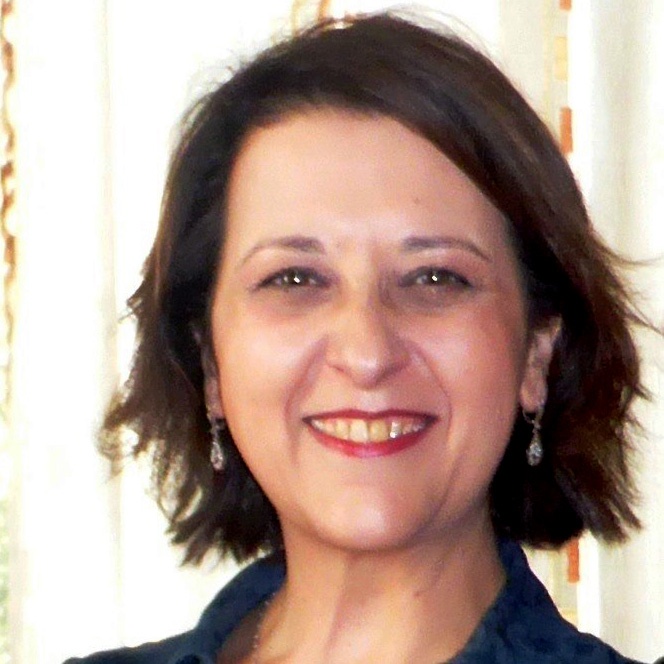
Librarian, Master in Literature. Researcher of the project in Italy.
Neruda Illustrated
Pablo Neruda: 20 Love Poems and a Desperate Song.
Attilio Rossi was born in 1909 in Albairate and died in Milan in 1994. He made a pictorial journey throughout the 20th century, ranging from abstract art to hyper-realism, breaching the frontier of the most advanced figurative art, whilst taking into account the most important experiments in contemporary art.
He had a deep relationship with Hispanic and Latin American culture during his long stay in Argentina (1935-1950), where he was the first artistic director of Editorial Espasa Calpe and then, in 1938, founder of the Losada Press with Guillermo De Torre, Francisco Romero and Gonzalo Losada. He created the logo for the new press. He also illustrated numerous books and covers for the volumes in which he edited the publication.
During this intense editorial work, Attilio Rossi established relationships of collaboration and friendship with numerous Spanish intellectuals. Among his friends was Pablo Neruda, for whom he illustrated Twenty Love Poems and a Desperate Song.
Neruda’s Poems
We have here a painter and a poet, two sublime interpreters of the same skills: to reach hearts hungry for beauty; free them from apathy by dragging them into a storm of feeling; heal them from loneliness by connecting them with the secrets of the world. One with the speed and explosion of a brushstroke; the other with the persuasive sigh of the word. There was a great affinity between both artists, they had the same desperate melancholy, the truth and the scars of history, its gaps and its faults. The two lived almost parallel lives, although with an opposite development: the Sicilian, during his youth, knew the atrocities of Mussolini’s Italy, which he actively opposed through his early artistic works; The Chilean in 1973, at a rather advanced age, witnessed the precise moment of Pinochet’s dictatorial rise before losing his life just ten days later. In the meantime, they had a meeting that would keep them eternally consecrated as companions in the fight.
As early as 1952, in the edition of Neruda’s Poetry, published by the Einaudi publishing house, translated by Salvatore Quasimodo, the text was accompanied by Guttuso’s splendid illustrations, in ink and charcoal in rigorous black and white to represent the expressive urgency and at the same time the raw pain of reality, both in the poems and in the drawings. It is quite plausible to think that the two met in the most important European cultural circles of the time and, therefore, established a deep bond of friendship. As confirmation of this thesis, we find a curious and significant episode that took place in 1956 when Guttuso married his beloved muse and partner Mimise and for the occasion, Neruda not only dedicated a poem to them, but even participated as a witness to the wedding.
The confirmation of their link is the evidence that Guttuso himself was one of those who immediately suspected the falsity of the official version issued by the regime, according to which Neruda had lost his life due to a tumour. So much so that Guttuso hastened to send his friend a drawing made on cardboard, in which Neruda, whose pose recalls the Marat painted by David at the moment of death, holds for the last time in his right hand his inseparable pen, a peaceful weapon of liberation and symbol universal rejection of all oppression. On the left, a page has an eloquent inscription: “Nixon Frei Pinochet” that Neruda himself had accused in his last poem, “The Satraps”. At the bottom of the card – from which an engraving was taken in Santiago de Chile, described by Salvatore Settis in an article published in “Il Sole 24 Ore” in 2013 – a simple, but moving farewell: “To Pablo, Renato “.1.
1 https://www.sicilianpost.it/il-mistero-della-morte-di-neruda-svelato-da-unopera-di-guttuso/
Neruda “literary character”
Some novels of recent publication have been inspired by various episodes in Neruda’s life: this is how he has become the protagonist.
The first and most famous is undoubtedly Burning Patience, by Antonio Skármeta, published in 1986 and translated into more than twenty languages. This is better known in Latin American countries by the title El Cartero de Neruda which was derived from the title in Italian. The story begins in 1969 in the small fishing village of Isla Negra, on the coast of Chile and ends four years later, in 1973, the year of the Chilean coup by Augusto Pinochet and the death of the poet.
It is the story of a special friendship at an even more particular moment in the history of Chile. It is a book of poetry, sweet and sour at the same time, sometimes picturesque in some descriptions, sometimes melancholic, but without being sad, rich in its simplicity. The initial part narrates the genuine friendship between two men who are very distant to each other by culture and social extraction who build a sincere relationship, based on dialogue, advice and deep conversations. As a setting, we find a wild and intact nature, which the author describes with extraordinary skill and adds sound of the ocean as poetic as Neruda’s verses. As the story progresses, the historical moment becomes more and more compelling and predominant. The narrative changes, going from descriptions and live situations, sometimes even funny, to the more serious tones typical of a convulsive political reality, with the victory of Salvador Allende and the changes first wrapped in hope, then surrounded by tensions and furious controversies and finally the dramatic changes that the new Chilean scene will bring. In fact, it is in the last pages – which are closely related to the evolution of the historical period and especially to the epilogue – where the author allows us to feel the scope of the events. (1)
The first Italian translation, by Andrea Donati, was published by Garzanti in 1989.
The film The Postman (Il Postino in Italian) was inspired by this novel in 1994, with a Chilean setting instead of Capri, where the famous Italian actor Massimo Troisi appeared for the last time.
1 https://www.mangialibri.com/libri/il-postino-di-neruda
Skármeta-Neruda. Magic in action.
The author of Neruda’s “The Postman” narrates the story of the great author of contemporary literature and presents an anthology of his works. Translation by Roberta Bovaia, Guanda, 2006.
Antonio Skármeta was just a child when he met Pablo Neruda. With the curiosity and emotion of someone who knows a revered poet, he brings him his first published verses; with the arrogance of youth he uses Neruda’s poems to impress his schoolmates; with the affinity that comes from a common geography, he fully understands him and, after his death, pays tribute to him with a book that will become a hit movie. With the distance of the years, Skármeta delves into the memories and the poet is still there, vital, important, unforgettable. Neruda and his muses, the women he loved, so different from each other: enthusiastic, sensual, mysterious, elusive; Neruda and his houses, wonderful and still living testimonies of a man who loved, travelled, lived; Neruda and the democratic spirit with which he related to the people, available with the simple, sharp with the pompous. Unrepeatable moments shared with Neruda, such as the evening he spent with Mario Vargas Llosa and Juan Rulfo, who expressed himself with his silences. Moving moments, like the memory of Massimo Troisi walking into a bookstore, browsing through Neruda’s Postman, buying it, reading it all in one night and proposing it to the producer. But this book is also an enlightening anthology, a selection of poems that touch on the great themes of Neruda, a compilation of the lyrics that most influenced the choices of the writer Skármeta and the man Skármeta, starting in Autumn, written perhaps a few months before of the Chilean coup and shortly before Neruda’s death: “I return to the sea wrapped in the sky.” Even the eternal and famous love poems.
Letting himself be guided by the master’s verses, Skármeta proposes a poetic and critical itinerary in which the poems suggest memories and reflections, ideas that illuminate Neruda’s life and work, anecdotes of an intense friendship and a great civil passion, which culminated in the death of Salvador Allende and the end of a political illusion.
Ruggero Cappuccio
La prima luce di Neruda
Milano, Feltrinelli, 2016
The novel narrates the attempted expulsion of Pablo Neruda from Italy and his planned departure from the station in Rome where Alberto Moravia, Carlo Levi and Renato Guttuso went to say good-bye, among others. Twenty years later in Chile, after the coup, Pinochet’s soldiers knocked on the poet’s door to threaten his freedom. Various episodes in the life of the Chilean poet are narrated: passion, hope in a world in process of transformation, darkness, violence, death. Two episodes are narrated in first person by the voice of the poet and the voice of Matilde, two existences that narrate the force of life and the greatness of being in the world, the civil charm of the word against the powers that would like it to be obtuse or distorted. Ruggero Cappuccio insinuates himself into the materiality and mystery of his characters, to slip his grace like a glove and ignite the exemplary vitalism of memory.
Paolo Manzi
Incontro con Neruda: un emigrante
Gaeta, Ali Ribelli , 2019
This is a journey made through the streets of the world and the streets of the soul, walking among the verses of Neruda, companion of an unforgettable itinerary. The poetry of the great poet is the “train” that allows the protagonist to reach his own soul, to get back in touch with the most intimate part of himself, to reach real change, a true metamorphosis. The protagonist’s migration thus becomes the migration par excellence, because it promotes and generates an interior renewal from which a new man will be born, capable of freeing himself from the ghosts of the past without denying his own roots.
Andrea De Simone – Tonino Scala
Pablo Neruda, la cipolla e le lacrime del compagno Alicata
Milano, StreetLib, 2020
This book is based in an onion-based culinary challenge between Pablo Neruda and the communist leader Mario Alicata. At the time of the great Chilean poet’s exile in Capri, he maintained ties with the intellectuals of the Italian Communist Party. Both protagonists came from territories where the onion is the queen of the kitchen and compete on Capri, the queen of the islands in the Gulf of Naples, where even a harsh exile for political reasons, becomes poetic inspiration and a zest for life. A novel that traces, through a challenge between dishes, a world that no longer exists, of which the memory has been lost. The authors, in a symphony of flavours described with great skill, transform a world into an imagined flavour, which goes from life to the feelings of two communists of bygone times. A way to share tasty, simple, and healthy dishes and to find a recipe that gives meaning to a struggle for liberation.
Neruda “hombre entre los hombres”
Giuseppe Bellini
Viaggio al cuore di Neruda
Firenze, Passigli, 2004
Giuseppe Bellini was the academic who initiated of the study of Spanish-American literature in Italy, as well as translator and editor of many of Neruda’s works.
This essay covers the entire history of the great Chilean poet, with special emphasis on the two perspectives of Neruda: the “epic”, which made him the most popular representative in poetry of the demands of oppressed peoples, and the most “intimate”, which has produced unforgettable collections.
Bellini captures the continuous and exhausting tension, existential and poetic, between opposite sides: tradition and renewal, dream and reality, humour and despair, memory and novelty, and love and death. Thus, he himself describes Neruda’s writing:
“For this reason, after so many years that I have dedicated to the study of Neruda’s work, I thought of rescuing from oblivion and, above all, organizing in a chronological-thematic journey, the essays and critical reviews that represent my interpretation in a production that because of its vastness and importance, is perhaps unmatched in twentieth-century poetry”.
Neruda’s work spanned the entire last century, getting involved or contaminated by events, often tragic, that characterized its development. It is at the same time epic, lyrical, political and love poetry, but, above all, it is a poetry that has man at its centre, his anxieties, his needs, both his illusions and his achievements. The man who is a being, according to Bellini, “vaster than the sea and its islands” and in which one must fall “as in a well”, come out “with a lot of secret water and submerged truths”.
Bellini says, “This is the depth of the message of the great Chilean poet, as I have tried to follow him in my Journey to Neruda’s heart; a trip to his secret regions, to find that man “clear and confused”, “rainy and happy”, as he defined himself, who in his work reflected an entire era, great and mean, contradictory and tragic, as an unforgettable moment of human adventure on earth”.
Loves, dreams, and utopia have meant that, throughout the second half of the 20th century, Neruda’s poetry apprehended, regardless of political orientations, the sensitivity of countless readers. At the dawn of the new millennium, I am convinced that Neruda’s poetry is still speaking to us.
Due to the importance that Giuseppe Bellini has in the study of Hispanic American literature, the Miguel de Cervantes Virtual Library Foundation has dedicated an ample section to him on the portal “Figures of Hispanic Culture”, offering the possibility of accessing a wide selection of critical materials from the academic Italian on cultural relations between Italy, the Iberian Peninsula and the New World.
Nicola Bottiglieri
Le case di Neruda
Milano, Mursia, 2004
In addition to his extraordinary poetic production, Pablo Neruda also left behind a strange and fascinating work written with objects, wood, concrete and nails, a true “real estate poem” that can be understood from the relationship between home and writing. Seeing the houses, it is possible to understand the poems about them, built and decorated with the rhythms and images of their verses.
Four houses are in Chile and were built by Neruda and furnished using materials collected in the most disparate places in the world. He also had another house in France, in Normandy, in the village of Condé-sur-Iton, an old mill-stable of which, however, traces have been lost. The original boat-shaped houses, full of rare and curious objects collected in all corners of the world, between an exile and a destination as Ambassador of his country, are the destination of incessant pilgrimages from all continents: La Chascona, which in Spanish means dishevelled, is in the heart of Santiago, and the sunny Sebastiana dominates the bay of Valparaíso. The hermitage nestled between the rocks of Isla Negra, with its beloved collection of distant gazing statues, is where the poet died. They are places full of memories and stories that have now become authentic museums that house all the objects with a marine theme collected during their trips abroad.
Then there are the residences in which he lived for rent, scattered around the world: the house of Las Flores in Madrid during the civil war, the house of Michoacán in Mexico City, and the one on the island of Sri Lanka, inhabited at the beginning of the 1930s, which waited for him his whole life and to which he returned 40 years later to find that it would soon be demolished.
After the poet’s death, the film “Il Postino” created the myth of another house. Neruda resided in Capri during the first half of 1952, in the house of Arturo Cerio, which was given to Neruda by the illustrious historian and naturalist Erwin Cerio. The film wants to evoke that happy stay, but for cinematic reasons the house scenes were shot in Salina, in the Aeolian Islands. Today tourists visit Salina’s decorated house, believing it to be Neruda’s real house, ignoring that he lived in Capri in 1952, where he wrote The Captain’s Verses and a large part of The Grapes and the Wind, especially the seventh section “The Homeland of the Grapes” entirely dedicated to Italy.
https://www.ruta40.it/letteratura/nicola-bottiglieri-case-pablo-neruda.php
Luis Sepúlveda, Renzo Sicco
Il funerale di Neruda-El funeral de Neruda
Torino, Claudiana, 2013
Pablo Neruda died just twelve days after the Chilean coup in which the democratically elected president Salvador Allende was assassinated. This book, masterfully and poetically written by Luis Sépulveda and Renzo Sicco, narrates those tragic twelve days. It is a theatrical text that has already been performed in several countries and at Neruda’s house in Isla Negra, and as a result of this performance, his former secretary raised the question of the true cause of death. Neruda’s funeral poetically represents the last moments of the writer’s life, amid the arrests and torture of friends and comrades, and his death and his funeral became a moment of collective protest against Pinochet and the military, the last free public demonstration in many years.
Josè Goñi
Pablo e Matilde. I giorni dell’esilio
Rome, Nova Delphi Libri, 2018
There are various testimonies in political books about Neruda’s self-imposed exile in Capri, and also short stories and essays by literary critics. Teresa Cirillo writes about it in Neruda in Capri (La Conchiglia editions), and there are many clues in the Sentimental Lexicon Book That Time Neruda… by Gioia Ramaglia Ricci.
The book “The Journeys of the Exile” that inserts the six months spent in Capri into the broader reasoning about the influence that the years of Neruda’s exile in Italy and Europe had on his literary work, is that of the Chilean politician and diplomat Josè Goñi. In 1949, Pablo Neruda, a communist deputy, was forced to flee Chile, initiating a period of exile that eventually led him to Capri with the singer Matilde Urrutia.
The poet dedicated passionate lyrics to his beloved woman and to the island that welcomed them, bringing them together in two splendid collections: The Grapes and the Wind and the mythical The Captain’s Verses. These were published anonymously in Naples in 1952, thanks to the subscription of the most famous exponents of the Italian intelligentsia, from Renato Guttuso to Luchino Visconti, from Carlo Levi to Giulio Einaudi, not forgetting Elsa Morante, Palmiro Togliatti, Giorgio Napolitano, and Antonello Trombadori. Forty-four subscribers for forty-four numbered copies of a book that Neruda officially recognized as his own only ten years later.
After extensive research, José Goñi goes through the stages of the Chilean artist’s stay in Italy in depth, outlining the unique political and cultural context that saw him as the protagonist, and presenting the figure of a poet completely immersed in his own time.
Gabriele Morelli,
Neruda
Rome, Salerno Editrice, 2019
The book reconstructs the existential stages and the earlier work of Neruda when he was younger, based on the collections Crepusculario and Twenty Poems of Love. It also recounts the encounters with Borges, the writer Guillermo de Torre and the poet César Vallejo on their journey to the East, where Pablo resides as Consul, while the first letters of Residence on Earth are born, inaugurating a new style of writing.
He then describes Neruda’s time in Madrid, successfully welcomed by García Lorca and representatives of the literary group Generation of 1927, and the poet’s political maturity in favour of social commitment and the Republic during the Spanish civil war, which inspired the book Spain in the Heart.
In the 1950s, pursued by an arrest warrant from President González Videla of Chile, Neruda reached Paris, then Italy and the island of Capri, where he lived his love affair with Matilde Urrutia.
The final chapter, after discovering the crimes of Stalin whilst still sympathizing with Salvador Allende’s socialist utopia, narrates the poet’s last secret love, describes the unpublished book Album de Isla Negra, and reconstructs the days of his death and the legend of his possible poisoning.
Roberto Ippolito,
Delitto Neruda. Il poeta premio Nobel ucciso dal golpe di Pinochet
Milano, Chiarelettere, 2020
September 11, 1973. At this time Pinochet’s military dictatorship was established in Chile and it was the end of a dream. Pablo Neruda’s houses are devastated, his books burned in bonfires in the streets. There is terror and death everywhere. Poetry is also considered subversive. Twelve days after the coup that deposed his friend Allende, the 1971 Nobel Prize winner for Literature, the poet of love and civil commitment, loved throughout the world, dies at the Santa María Clinic in Santiago. The same in which, years later, former President Frei Montalva, an opponent of the regime, died of poisoning. Neruda’s death occurs on the eve of his departure to Mexico, officially for prostate cancer.
But the medical history disappeared, the autopsy is missing, the death certificate is false. Ippolito gathered the clues leading to sustainable evidence, and the reason for the end of Neruda, from the judicial investigation aimed at clarifying the hypothesis of the murder and therefore contrasts in every way to the nostalgic and deniers. For his dramatic reconstruction, the author made use of extensive documentation from the most diverse sources: archives, expert reports, scientific articles, testimonies, printed and online newspapers, radio, television, blogs, books, in Chile, Spain, Brazil, Mexico, Peru, the United States, Germany, the United Kingdom and Italy. The book is written with the rigour of an investigation and the style of a thriller. Neruda is a symbolic figure of the fight for freedom, not only in Chile. He is a victim like García Lorca, his great friend and illustrious poet, assassinated by the Franco regime.
Pablo Neruda in Italian cinema
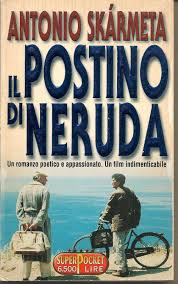
Neruda reader

Writer and screenwriter. With Massimo Troisi, she writes several four-handed film scripts. The film “Neruda’s Postman” (1994), was nominated for an Academy Award, in various categories. As a writer, she has published ten novels, one of the most widely read by the public is “Da domani mi alzo tardi” (2009).
Neruda in the Italian cinema: The Postman (1994)
Antonio Skármeta wrote “Neruda’s Postman” in 1986 and in 1994 Michael Radford directed a film based on the book starring Massimo Troisi. This film had 5 Oscar nominations: Best Direction, Best Leading Actor, Best Non-original Screenplay, Best Production, and the statuette was won by Luis Bacalov for Best Soundtrack.
I had the opportunity to meet Antonio Skármeta in Italy, at the Turin Book Fair, after having first met him in the pages of his novel, when I made – together with Massimo Troisi and Michael Radford – the film adaptation. I kept the memory of a kind, gentle person and it seemed to me that the man corresponded perfectly to the artist, that the book belonged to him like his serenity, his smile, his lively gaze and the wonderful language in which he spoke, but which I did not understand. In this way, it was a meeting of sensitivity, of assumptions, of facial expressions that, however, left an unforgettable mark on me.
Nobody better than him could have narrated the private Neruda, nobody could have taken us to his house in Isla Negra, show it while he dances with Matilde or cooks with an onion in one hand and a knife in the other, transforming everything into poetry. And follow him later in his disenchantment at the news of the Nobel Prize, appreciated, but received with modesty, without self-celebration or vanity. He restored us to the man capable of listening to the forgotten, the same man who carried with painful empathy the voice of the miner, “a faceless creature, a mask of sweat, dust and blood” that he himself saw emerge from the viscera of the Chilean land. A simple postman, not very cultured, but with a keen sensitivity and many ideals, thanks to Skàrmeta’s pen he becomes the poet’s best confidant, the one who asks for consolation in exile, begging him to send him the sounds of the island. I have always wondered if that postman ever existed and, if not, in what fold of reality the author was inspired to invent such a true and credible character.
Massimo Troisi had an acute sensitivity, was a poetic soul, an author, a director, a talented Neapolitan actor, who in Italy is considered heir to the genius of Eduardo de Filippo. Troisi reads the book and falls in love with him. Precisely the idea of peering into the less obvious aspects of the soul of the Poet, being able to give reality to the life that hides behind a verse and, even more, to the beautiful but blinding light of the most prestigious prize in the world, the Nobel, led Troisi to the desire to make it the masterpiece of his own artistic and personal life. Of course, he could not foresee that the film would have wings so strong that it would fly abroad and reach the Oscars, but he put all the ingredients to make it exceptional: talent, passion, professionalism to which fate added a cross that Massimo embraced with courage and determination.
In the film we see everything, not only the artistic product, but the soul, which appears naked on the screen, as if the image, the hollow face, the slim body, were only the material medium of the impregnable interiority that permeates the character. “The Postman” was Massimo Troisi’s last film: he shot with the last force that a heart gave him awaiting a transplant. He stubbornly refused to postpone filming, to interrupt when he felt tired. One Friday in June he finished his work, greeted everyone, took the classic photo at the end of filming and said, “Don’t forget me.” On Saturday afternoon he fell asleep and left.
“The Postman” seems to unconsciously contain his own future, he has a sense of pain and the end of things that starts from the fiction of the story and the film to continue in real life in a resounding way. Fiction is painfully confused with reality. But in the film there is not only sadness, it is also governed by smiles and poetry, the same ingredients of the book, although the adaptation required many changes. A change of time, from 1973 to 1952, of the environment, from Chile to Italy, from the age of the protagonist who, from being a seventeen-year-old youth, becomes an ageless adult, but with dreams and aspirations intact and pure. Adapting the novel was fascinating. While the Postman, a character born of the writer’s creativity, allowed more freedom, Neruda asked for a job that had to be respectful of the greatness known to all. It was not always possible to make use of the novel’s dialogues, because many of the elements that make the character great on paper are narrated and not dialogued. How to make the poet speak in the film while still being at his height? The solution was “I confess that I have lived”, written by Neruda himself in first person.
Deepening in the words expressed by the Poet it was possible to build his dialogues. The character of Mario Jiménez, who in Italy becomes Mario Ruoppolo, in the novel has the freshness of youth, but finds its vivacity in the talent of Massimo Troisi. There are many licenses that must be taken to transform a good book into a good movie, such as inserting more than one fictional narrator in the story and forgiving yourself. However, there was an element in ‘Neruda’s Postman’ that really needed to be respected, the poem that in the end is saddened by the death of Pablo Neruda, which occurred during the Pinochet coup.
Yes, it was a fictional storyteller, but the poet certainly could not die twenty years in advance. Thus, to preserve the sense of loss that permeates the end of the story, it was inevitable that the Postman would die and that the condolences that are his in the novel would be instead of the Poet: Pablo Neruda, returning to the island where all the events had taken place, he discovers that his friend and confidant is gone forever. But there is his son, who was orphaned before he was born and who bears his name, Pablito. Unfortunately, that sense of death came out of fiction and into reality, with the death of Massimo Troisi a truly unfathomable void was created for all of us who knew him and for the public who loved him. Seeing this movie comforts us and at the same time it still hurts us to this day.
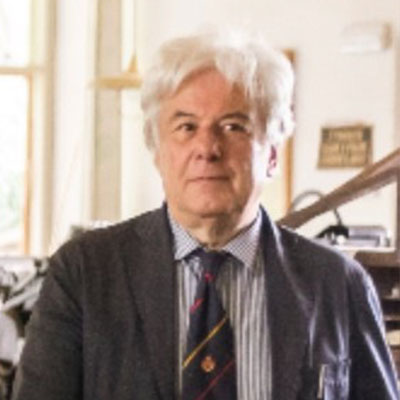
Editor.
As testimony of the bond between Neruda and the publisher, we have selected the transcription of the speech with which the Poet, on November 12, 1970, inaugurated the exhibition “Tribute to the Book and Alberto Tallone”, at the Italian Library of Santiago de Chile.
Homage to the book and to Alberto Tallone (1970)
When speaking of Gutenberg and the invention of printing, Lamartine coined this beautiful expression: “The printing press is the telescope of the soul …”. A telescope that communicates us the secret thought of the past, the present incessant work, and the future’s unknown.
Those so-called “luxury” books, which we often have the inclination to condemn, because they seem to be only accessible to few, do not hinder the popularization of the book which is produced in millions of copies, which crosses all the alleys and reaches all the houses, reflecting in its way the great errant work of the thought.
But a tradition of making beautiful book does exist, which aims at the same perfection once reached in painting and sculpture. This is the work of man to whom many wonderful artists have dedicated their lives. Among them was Tallone.
Tallone from Italy for many of you is just a name, while it means so much to me. I had admired his work even before I met him: his beautiful books, his immaculate typeface designed by himself. And I never thought that life would do me the great honor of having my books printed by him.
It happened one day, that I received an invitation from him. He lived near Turin, “presso Torino”, in Alpignano, and there we went, Matilde and I, by train. Yes, I knew where the house was, the printer had told me: the house is on this side of the railway. And we got there, but suddenly I felt disorientated; it seemed impossible, there was a steam locomotive with carriages, and the locomotive was smoking. I told Matilde: “We took the wrong way”.
No, sir! Among other things, Tallone was a collector of locomotives and he had one started so that the smoke would announce his house to me from afar.
I went through the bright room where there was people at work, the large workshop: an almost exact duplicate of Gutenberg’s printing press. The large tables, the metal letters set one by one, the shelves full of reams of wonderful Italian paper.
And then the conversation, the pleasantness of the wine – a white wine produced in the surroundings of Turin. But most of all it was his love for typography, his immense vocation as a printer, his absolute dedication to every page of his books, that illuminated him and beamed from his soul.
That European light went out, that humanist passed away, it is not long, leaving the book I wrote for him unfinished, “La Copa de Sangre”.
Bianca Tallone wrote me: “Alberto has left us, but I will finish the book and I will keep the Press alive; I feel responsible for this workshop and the great quality it is committed to”.
Tallone, among so many masters of typography, was the most rigorous, the most demanding. The slightest fault was a sin for him, a wound hat stood out from each printed line.
For instance, some of my books required six months of work, because a single accent was slanted in a different way than it should have, and he had to bring it back to its correct position.
The commitment, the decorum, the supreme beauty of his books are something to behold. He printed all the Italian classics and many great French poets, such as Ronsard. But it was in printing the most eminent Italian ones, from Dante to Machiavelli, from all the branches of Italian literature, that he achieved absolute excellence.
Here, then, I entrust you with a name which is, to me, unforgettable, and which shall enlighten us through his work.
PABLO NERUDA
Santiago, Chile, November 12, 1970
Interview with Alberto Tallone (1966).
Enrico Tallone (2021)
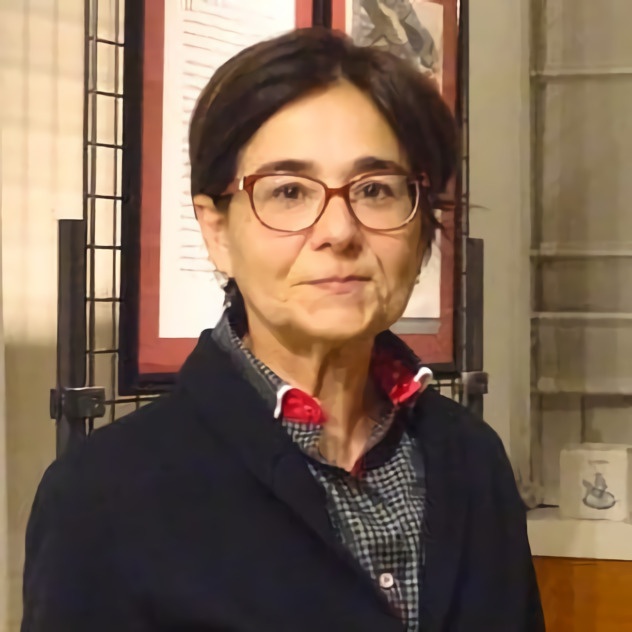
Librarian, specialist in ancient books. Curator of cultural exhibitions. Member of the Società Bibliografica Toscana. Responsible for this project in Italy.
Pablo Neruda and Alberto Tallone: a literary friendship
Neruda had admired Tallone’s editions since the 1940s. In 1939, he was appointed as the Consul in Paris (for Spanish immigration), at the time that Tallone had started his own publishing house by taking over the prestigious Maurice Darantière printing workshop.
However, the first meeting between the Chilean poet and the Italian publisher took place in Italy in 1962, when Neruda wanted to entrust Tallone with the unpublished collection of stories titled “Summary. Book where the rain is born”. The introduction to the collection was printed using handmade characters designed by Alberto Tallone, and Neruda expresses with these words his admiration for the originality of his editor friend: “Now this bouquet of Antarctic shade must be arranged in the beautiful typography to deliver its harshness to Tallone, master of supreme clarity, to illuminate understanding. I never thought, in the solitude where I originated, that I would achieve such honour, and I give these incomplete pages to the virtue of the great printer as when in my childhood I discovered and opened a wild honeycomb in the mountains. I knew then that the wild honey that scented and flowed in the tormented tree was housed in linear cells, and thus the secret sweetness was preserved and revealed by a fragile and firm geometry”. (Valparaíso 1962).
The meeting was special due to the presence of a steam locomotive that is still preserved (on real tracks) in the garden of the Tallone Press and which was the setting for their first meeting; a breath of steam welcomed the poet and his wife Matilde Urrutia and made this meeting even more significant.
To celebrate the 50th anniversary of Pablo Neruda’s Nobel Prize, the Tallone publishing house has recently completed a careful restoration of the locomotive so beloved by the poet. “Summary” was followed by another first edition – “The Blood Cup” – which was also composed and hand-printed by Tallone Press in a limited edition of 507 copies. The volume contains the ode “Goodbye to Tallone”, dedicated to Alberto who had died a year earlier, at the age of 70. From the highest point of his poetic inspiration, Neruda concludes the ode with these words; “Goodbye, Alberto Tallone, great editor, dear friend: before you had the light in your eyes, now the night travels in them. But in your books, castles of man, beauty and clarity continue to shine: through those windows the night will not enter. “
The following is a quote from the interview with his son Enrico Tallone, conducted by Fabrizio Fantoni, http://poesia.blog.rainews.it/2014/09/enrico-tallone-larte-di-fare-i-libri/
“The memories I have of the great poet are those of a man with the voice of a lamb who loved life and valued work, singing about it with brave and comprehensible words that made it universal. The son of a train conductor, he was thrilled to find a steam locomotive whose engine my father had ignited in his honour in his publisher’s yard. That is why Isla Negra still stands today with a steam locomotive that he wanted to place in front of his house-museum. “
The Stockholm Speech, published in 1972 on the occasion of the awarding of the Nobel Prize for Literature (October 21, 1971), was also published by the Tallone Press with the first edition in Spanish, followed by the Italian translation in 1999.
After Neruda’s death, Matilde sent Bianca Tallone the unpublished “2000”. Bianca, who had been widowed and had to run the publishing house with two young children, was forced to put the project aside at that time. Printed in 1974 by Editorial Losada in Buenos Aires, it appeared in Tallone typefaces in 2004, on the occasion of the centenary of Neruda’s birth. That edition of “2000” also contains the moving Matilde’s letter from 1973, and was composed and typeset by hand, and 360 copies were printed on pure Sicilian cotton paper.
The “Ode to Typography” appeared in Santiago de Chile in 1956 in Spanish, published by the Nascimento publishing house, and the first Italian edition dates from 1983. As soon as the 156 copies were released by the Piedmontese press, it became unattainable. The edition was in quarto format, composed by hand in Caslon font which originated in the 18th century. It was composed by the brothers Aldo and Enrico Tallone in memory of the poet and in memory of their father Alberto. It is part of “The Elemental Odes”, also important because they were conceived by Neruda during his productive stay in Capri. This is what Pablo Neruda wrote in this poem: “Letters, / continue to fall / like necessary rain / in my path. / Letters of everything / what lives / and dies, / letters of light, of moon, / of silence, / of water, / I love you, / and in you / I gather / not only thought, / and combat, / your clothes, / the senses / and the sounds: / A / of glorious oats, / T / of wheat and tower / and M / as your name / of apple.” And even though, when the verses were written, the meeting with the printer was still far in the future, in “Ode to Typography” he pays an explicit tribute: where A and T refer to the initials of the future friend, while M refers to beloved Matilda. “Ode to Typography” was reprinted in 2010 in a limited edition of 220 copies in Octavo format hand-composed with fonts created by Alberto Tallone. It contains, in addition to Goodbye to Tallone, the unpublished speech made by Pablo Neruda at the opening of the Tallonian exhibition in Santiago de Chile in November 1970, entitled “Tribute to the book and Alberto Tallone”, and also a study by Maurizio Nocera.
By virtue of the sincere friendship between Pablo Neruda and Alberto Tallone, and the work carried out together, publication (perhaps by Tallone) of a work not previously published would be desirable for the fiftieth anniversary of the great poet’s death in 2023.
Alberto Tallone (1898-1968), Italian publisher and printer, was the son of the painter Cesare Tallone and the poet Eleonora Tango. From 1932 he was an apprentice at the Maurice Darantière printing house in Châtenay-Malabry, dating from the late 18th century. In 1938 he took over, and then went on to found his own publishing house: Alberto Tallone Editore, based in Paris. Starting in 1957, he moved the publishing house to his maternal property in Alpignano, near Turin. During the sixties, Pablo Neruda visited Alberto, who published three works for Neruda in the first worldwide edition. Printing was carried out after his death by his widow, Bianca, and his sons Aldo and Enrico Tallone. The printing house is currently managed by Enrico, assisted by his wife María Rosa, along with their children Eleonora, Elisa and Lorenzo.
Pablo Neruda ed Alberto Tallone ad Alpignano
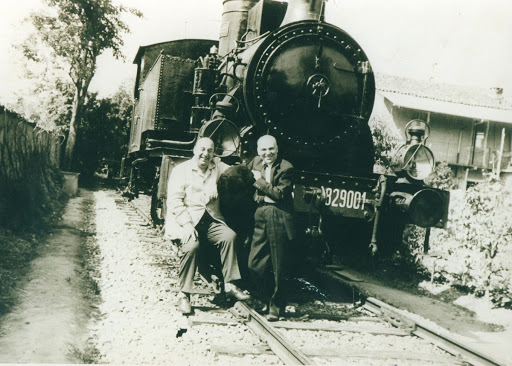





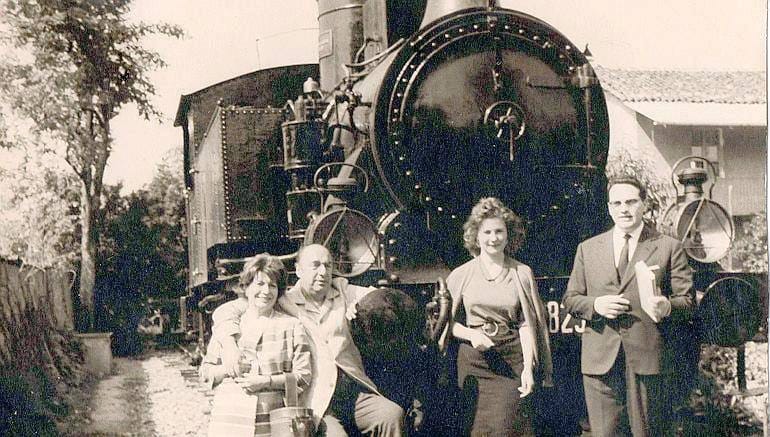



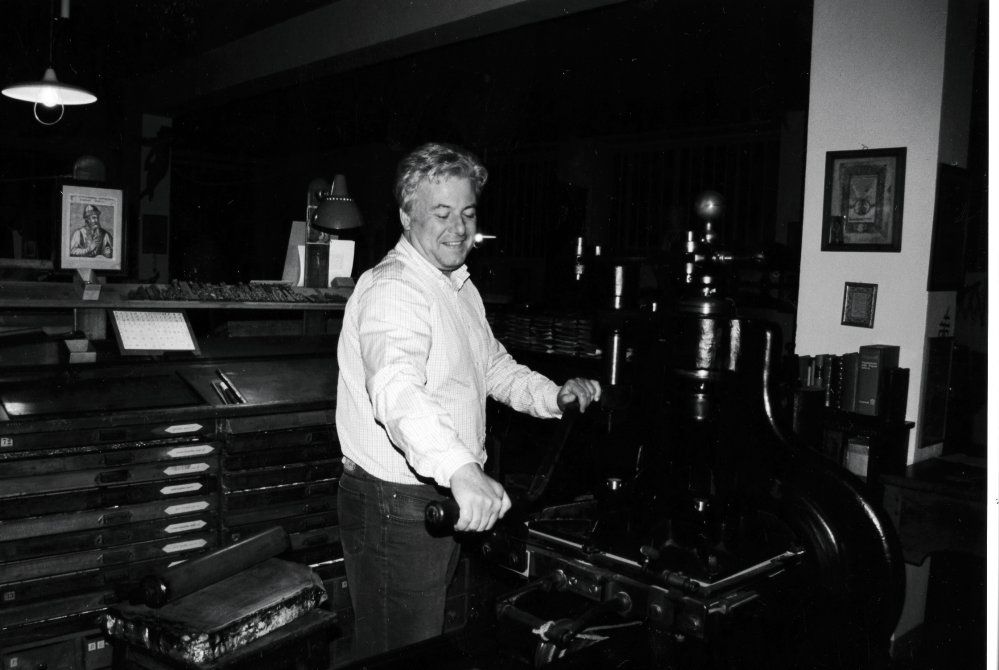



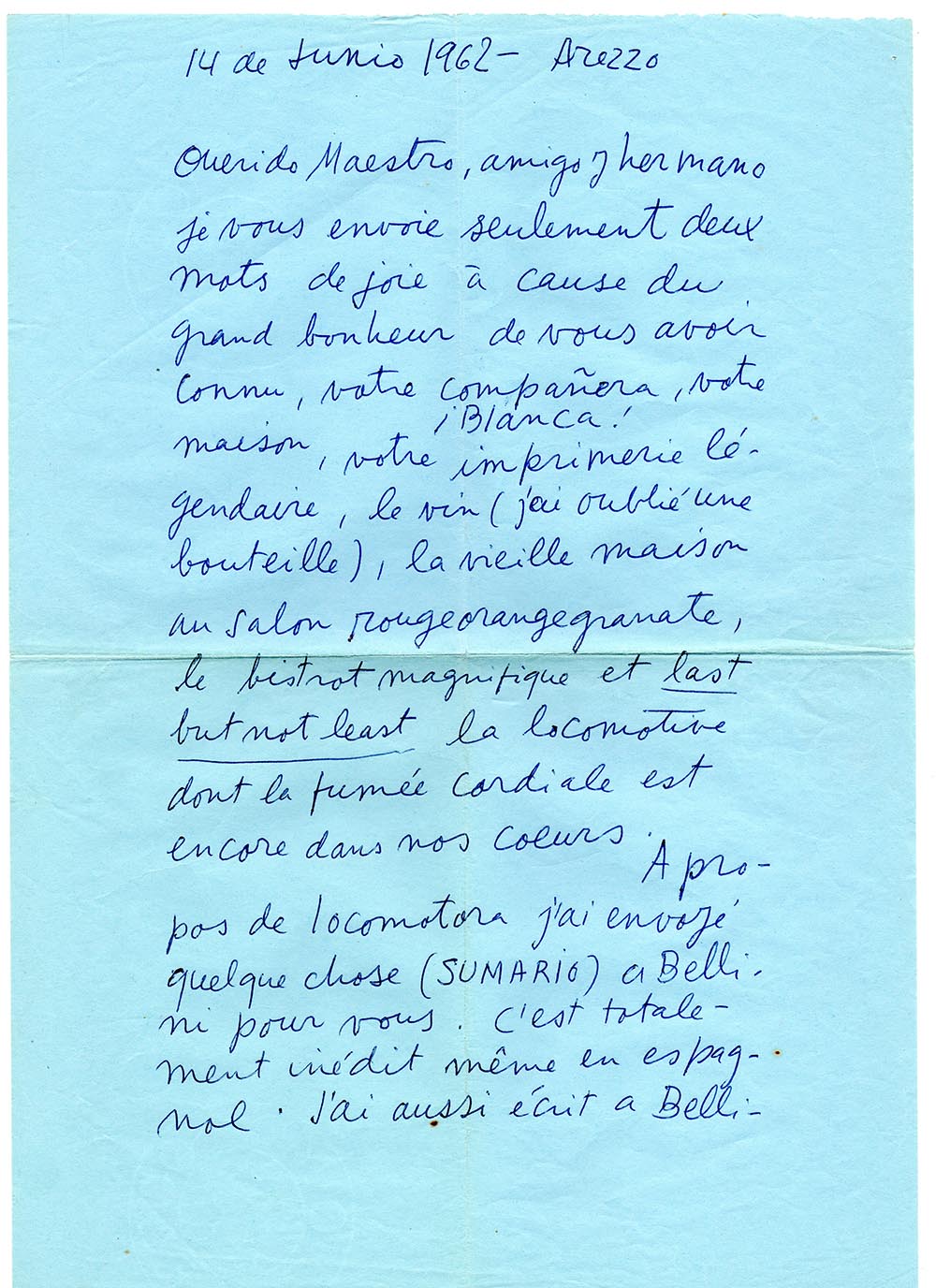

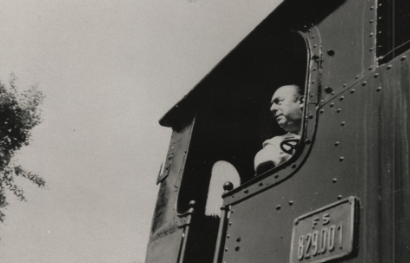

Pablo Neruda con suo amico Alberto Tallone.
Pablo Neruda e Matilde Urrutia.
Pablo Neruda con Enrico Tallone, Alberto Tallone e Matilde Urrutia.
Matilde Urrutia, Pablo Neruda, Bianca Tallone e Giuseppe Bellini.
“Ai Tallone, i nostri cuori. Pablo e Matilde. 1967.”
Enrico Tallone.
Pablo Neruda e la locomotiva.









Sumario. Libro donde nace la lluvia (1963)
La copa de sangre (1969)
Discurso de Stockholm (1972)
Que se despierte el leñador (1948)
NERUDA, PABLO.
Que se despierte el leñador (1948)
Rome : Rinascita, 1951. 8 p. : ill. ; 28 cm.
Extremely rare extract from Rivista Rinascita containing the poem (previously published in Canto general) which in 1950 also won the World Peace Prize for Literature in Warsaw; the translation is by Mario Socrate and Dario Puccini. The illustrations in the text are by the painter Renato Guttuso, who also portrayed his poet friend during a visit to Rome.



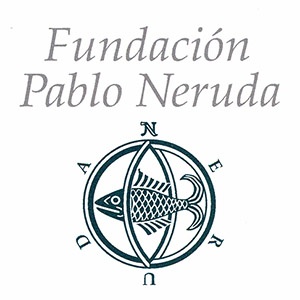



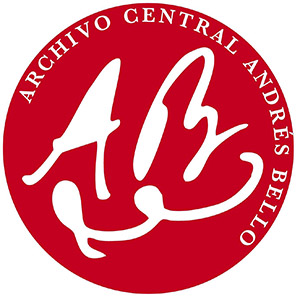
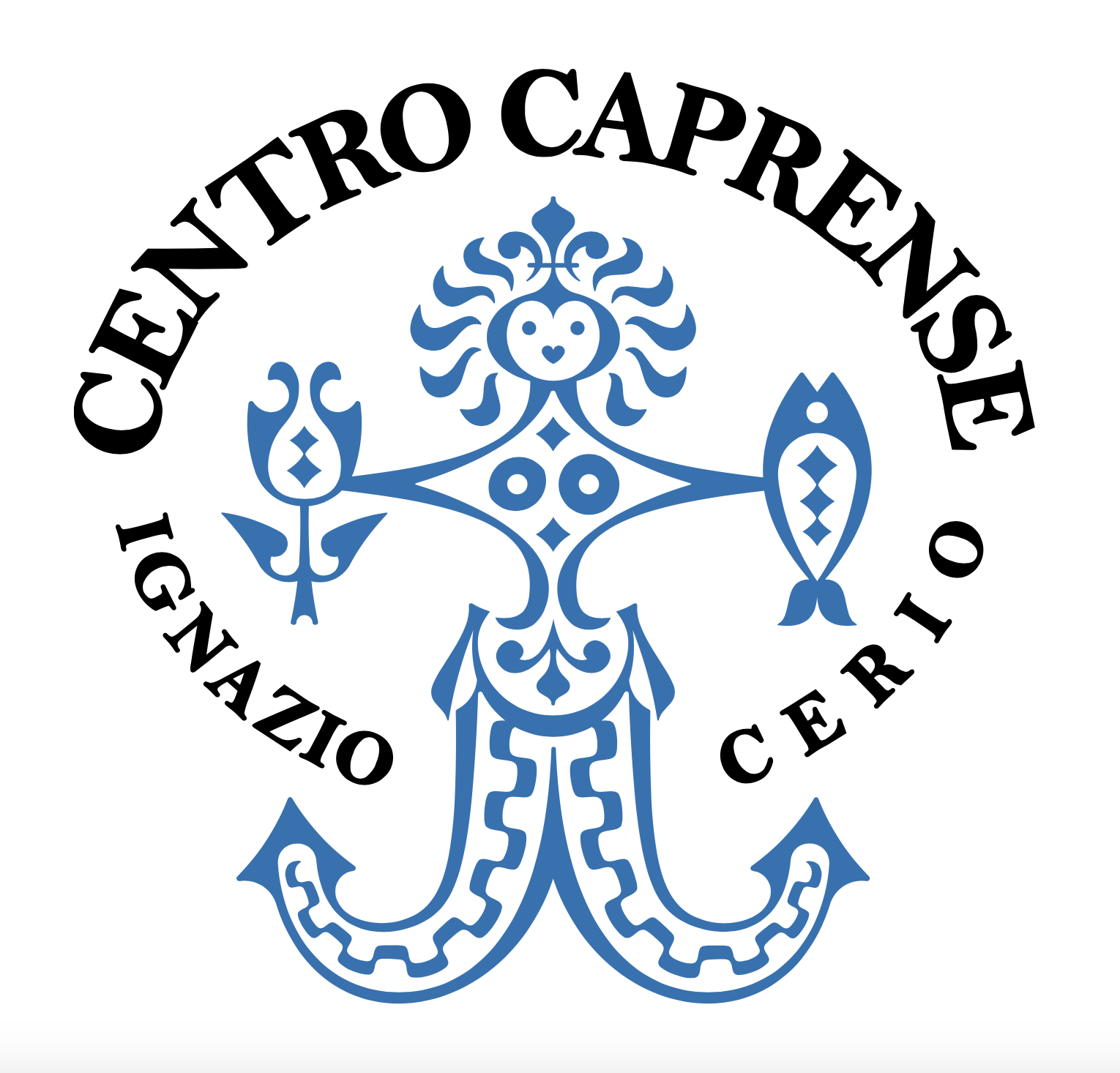
Ricardo Couyoumdjian, President of the Society of Chilean Bibliophiles.
Norma Alcaman Riffo, Director of the Society of Chilean Bibliophiles and Director of this Exhibition.
Enrique Inda Goycoolea, Director of the Society of Chilean Bibliophiles, Vice President of the Pablo Neruda Foundation. Collector and member of the Neruda Committee of this Exhibition.
Ignacio Swett Lazcano, Treasurer of the society of Chilean Bibliophiles. Collector and member of the Neruda Committee of this Exhibition.
Sandra Gutiérrez Alcaman, Director of the General Historical Archive of the Ministry of Foreign Relations of Chile.
Roberto Fuenzalida González, Member of the Society of Chilean Bibliophiles and Director of the Chilean Cultural Heritage Corporation.
Nurieldin Hermosilla Rumie, member of the Society of Chilean Bibliophiles and Neruda’s collector.
César Soto Gómez, Poet. Member of the Society of Chilean Bibliophiles and Neruda’s collector.
Edgardo Corral Sereño, member of the Society of Chilean Bibliophiles and Neruda’s collector.
Andrés Morales Milohnic, Doctor en Literatura. Profesor Titular de la Universidad de Chile. Miembro de la Academia Chilena de la Lengua y del Instituto de Chile. Poeta.
Franco Brzovic González, Abogado, Socio de la Sociedad de Bibliófilos Chilenos.
Cristián Zegers Ariztía, Abogado, Socio de la Sociedad de Bibliófilos Chilenos.
Darío Oses Moya, Periodista. Escritor y Director de la Biblioteca Fundación Pablo Neruda.
Sebastián Edwards, Economista, Socio de la Sociedad de Bibliófilos Chilenos.
Faride Zerán Chelech, Periodista, Vicerrectora de Extensión y Comunicaciones, Universidad de Chile.
Abraham Quezada Vergara, Diplomático. Doctor en Estudios Latinoamericanos y Magíster en Relaciones Internacionales. Profesor de Historia. Escritor.
Paolo Tiezzi Mazzoni della Stella Maestri, , President of Società Bibliografica Toscana
Alessandra Basso, Member of the Società Bibliografica Toscana y Responsible for this exhibition in Italy.
Maria Schirripa, Member of the Società Bibliografica Toscana and researcher for this exhibition in Italy.
Eduardo Constanzo Insunza, Doctor en Educación. Investigador de Booklife Asesorías Editoriales. Socio de la Sociedad de Bibliófilos Chilenos.
Carmelina Fiorentino, Bibliotecaria del Centro Caprense Ignazio Cerio, Capri.
Eleonora Tallone, Tallone Publishing House.
Enrico Tallone, de Alberto Tallone Editore (desde 1938), Alpignano, Torino.
Massimiliano Marino, proprietario del texto "Si desti il taglialegna".
Annalena Cimino, poetisa de Capri, Italia.
José Goñi Carrasco, Economista e escritor. Ex Embajador de Chile en Italia (2000-2004). Socio de la Sociedad de Bibliófilos Chilenos.
Marianna Fatti, Master of Science - MS, GIO – Economía y Gestión de Organismos Gubernamentales e Internacionales. Socia de la Società Bibliografica Toscana.
Fausto Rossi, propietario de la Tipografía Rossi (desde 1958), Sinaluga, Siena. Socio de la Società Bibliografica Toscana.
Bianca Croitor, fotógrafa, colaboradora y socia de la Società Bibliografica Toscana.
Antonio Li Gobbi, General del Ejército italiano. Caballero y Comendador, Orden al Mérito de la República italiana.
Anna Pavignano, escritora y guionista. Con Massimo Troisi, escribe varios guiones cinematográficos a cuatro manos. El film “El cartero de Neruda” (1994), fue nominado al Premio Oscar de la Academia, en varias categorías. Como escritora, ha publicado diez novelas. Una de las más exitosas, es "Da domani mi alzo tardi" (2009).
Franco Simone, cantautor. Obtuvo el 1° lugar en la competencia de música popular en el LVI Festival de la Canción de Viña del Mar, en 2015.
* Costa Rica: from San José, Arabella Salaverry, writer, 2016 and 2019 National Prize for Literature.
* France: from Paris, Justo Pastor Mellado, Cultural Attaché of the Chilean Embassy in France.
* Italy: from Rome, Sergio Romero, Ambassador of Chile in Italy - Konrad Paulsen, Cultural Attaché of the Embassy of Chile in Italy.
* Jordan: from Amman, Juan Vicente Piqueros, Director of the Cervantes Institute of Jordan.
* Peru: from Lima, Alejandro Neyra, Minister of Culture of Peru.
Contact: bibliofiloschilenos@gmail.com
![]()